L02 Carbohydrate Metabolism Glycolysis, Gluconeogenesis, Glycogen Metabolism, and the Pentose Phosphate Pathway
一、Glycolysis: An Overview
Catabolic and anabolic processes in anaerobic carbohydrate metabolism
- The gold arrows show the glycolytic pathway and the breakdown of polysaccharides that supply this pathway.
- Glycolysis(糖酵解) generates ATP anaerobically and provides fuel for the aerobic energy-generating pathways.
- The green arrows show the gluconeogenesis(糖异生) pathway, the synthesis of polysaccharides such as glycogen.
- The blue arrow shows the pentose phosphate pathway, an alternative carbohydrate oxidation pathway needed for nucleotide synthesis.
- The numbers 1, 2, and 3 identify the three stages of metabolism
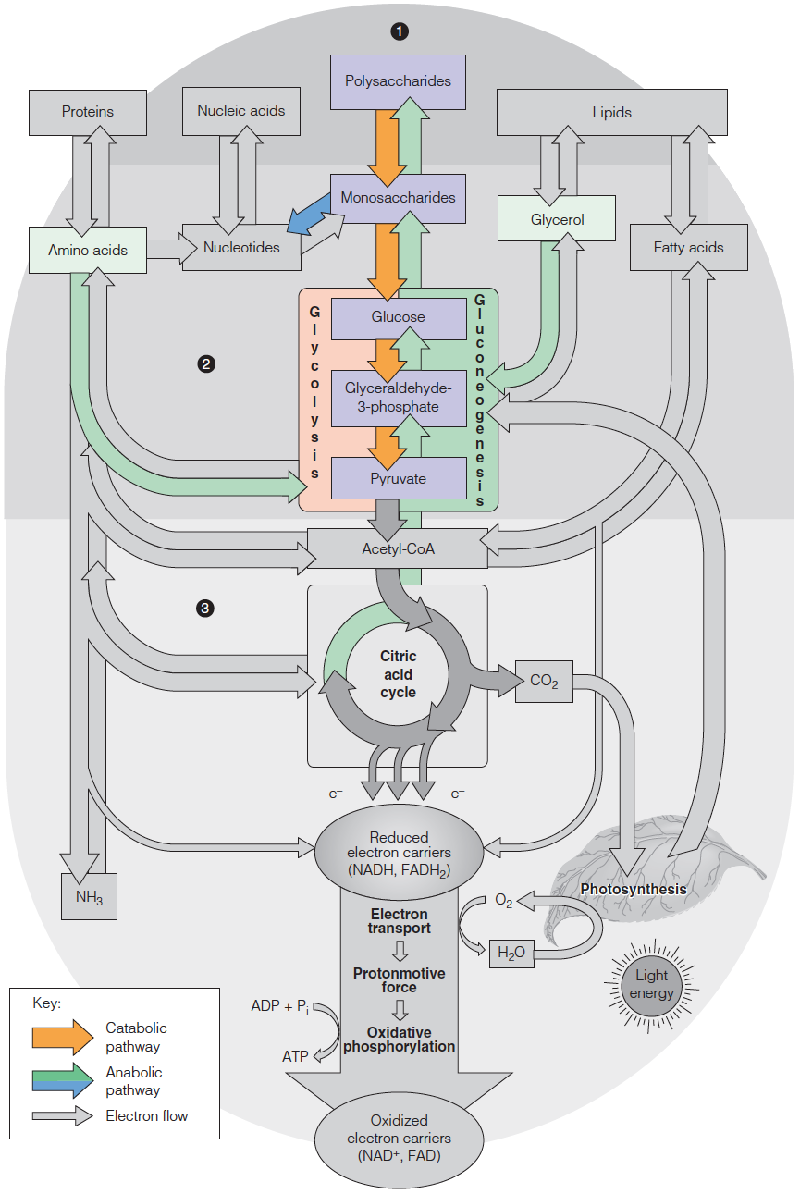
Two Phases of Glycolysis
The two phases of glycolysis and the products of glycolysis:
- Energy Investment Phase
- Energy Generation Phase
Glycolysis is an ancient metabolic pathway (evolved before the earliest known photosynthetic organisms began contributing O2 to the earth’s atmosphere.
Glycolysis is the first metabolic pathway!
In animal cells, pyruvate’s fate:
- acetyl-CoA, citric acid cycle (aerobic glycolysis)
- lactate(乳酸)
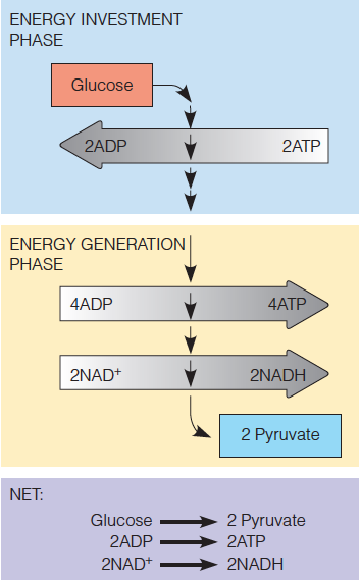
Mature RBC(Red Blood Cell): no mitochondria, highly dependent on glycolysis for ATP
Fermentation
1. Homolactic Fermentation
A fermentation (发酵) is an energy-yielding metabolic pathway with no net change in the oxidation state of products compared to substrates.
Anaerobic glycolysis (like aerobic glycolysis) leads to pyruvate, but the pyruvate is then reduced, so no net oxidation of glucose occurs.

1 | |
Louis Pasteur: fermentations are carried out by microorganisms (in 1856)-a milestone in the history of science!
Later (in 1897) two other scientists: fermentation occurs under cell-free condition-leading to discovery of enzyme;
$$
\text{pyruvate + NADH + H}^{+} \rarr \text{L-Lactate + NAD}^{+}
$$
2. Alcoholic Fermentation
Alcoholic fermentation(酒精发酵) involves cleavage of pyruvate to acetaldehyde and CO2 with the acetaldehyde then reduced to ethanol by alcohol dehydrogenase(乙醇脱氢酶):
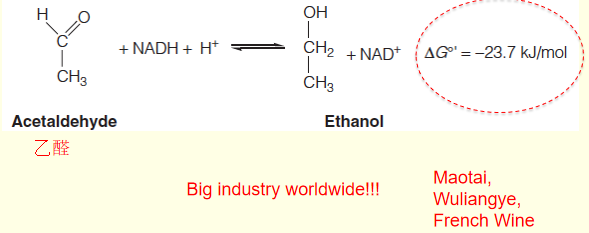
1 | |
3. Summarize to Fermentation
Fermentations use a common strategy to regenerate oxidized NAD+.
No net change in the oxidation state in all fermentation!
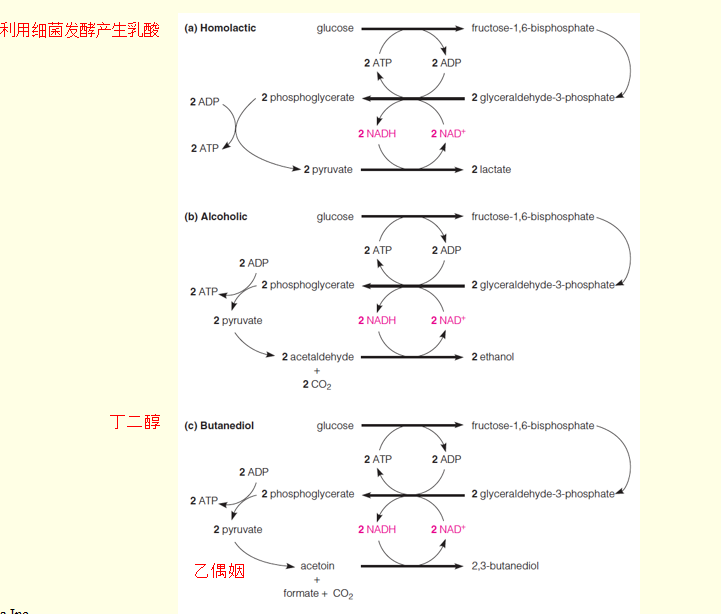
二、Reactions of Glycolysis
The chemical strategy of glycolysis can be condensed into three processes:
(10 Steps)
- Add phosphoryl groups to glucose, yielding compounds with low phosphate group–transfer potential = priming (底料,装填物).
- Chemically convert these low phosphate group–transfer potential intermediates into compounds with high phosphate group–transfer potential.
- Chemically couple the energy–yielding hydrolysis of these high phosphate group–transfer potential compounds to the synthesis of ATP by transfer of the phosphate group to ADP.
Three Routes to Synthesize ATP
ATP is synthesized by three major routes:
Substrate-level phosphorylation 底物水平的磷酸化
Direct transfer of a phosphoryl group from a donor compound to ADP, yielding ATP
Oxidative phosphorylation 氧化磷酸化(机体内形成ATP的主要方法)
Indirect synthesis of ATP by ATP synthase driven by the proton gradient cross the mitochondrial inner membrane.
Photophosphorylation 光磷酸化(植物、藻类形成ATP的主要方法)
The utilization of photosynthetic light energy to generate a proton gradient and ATP in plants and some microorganisms
Glycolysis produces ATP via substrate-level phosphorylation
An overview of glycolysis:
This condensed view of glycolysis shows the key intermediates and reactions in each of the two major phases.
In the energy-generating phase, two ATPs are produced for each ATP utilized in the energy-investment phase.
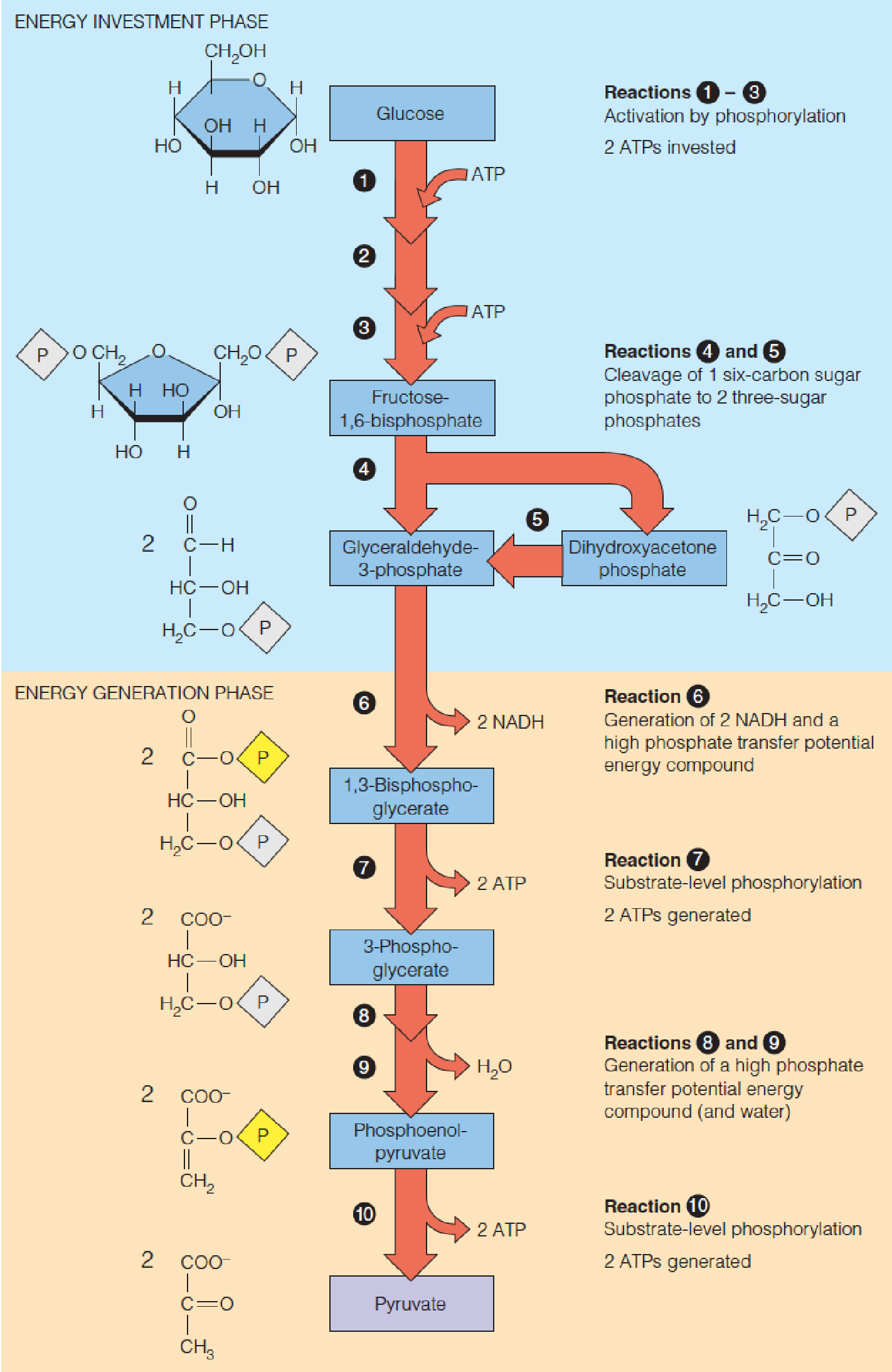
First 5 Reactions: Energy Investment Phase
The first five reactions constitute the energy-investment phase of glycolysis.
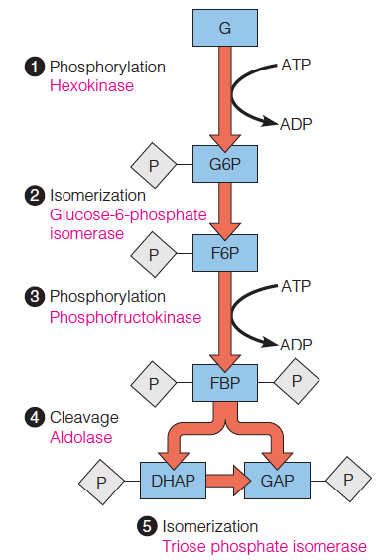
1 | |
1. Reaction 1: The First ATP Investment
glycolysis begins with the ATP-dependent phosphorylation of glucose, catalyzed by hexokinase.(己糖激酶)

1 | |
Mammals possess several molecular forms of hexokinase .
Different molecular forms of an enzyme catalyzing the same reaction are called isoenzymes, isozymes(同工酶), or isoforms.
Most tissues express hexokinase I, II, or III, all low KM enzymes. (对底物的亲和力较高)
Because intracellular glucose levels (2–15 mM) are usually far higher than the KM value for hexokinase, the enzyme often functions in vivo at saturating substrate concentrations.
A low affinity isozyme of hexokinase IV in liver with a sigmoidal dependence on glucose concentration permits that organ to adjust glucose utilization to glucose supply at high blood glucose levels.
Liver plays a key role in maintaining blood glucose level. (由于己糖激酶Ⅳ的低葡萄糖亲和力,liver有特殊的生理意义)
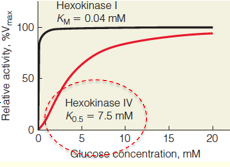
2. Reaction 2: Isomerization of Glucose-6-phosphate.
The next reaction, catalyzed by glucose-6-phosphate isomerase (also called phosphoglucoisomerase), is the readily reversible isomerization of the aldose, glucose-6-phosphate (G6P), to the corresponding ketose, fructose-6-phosphate (F6P).
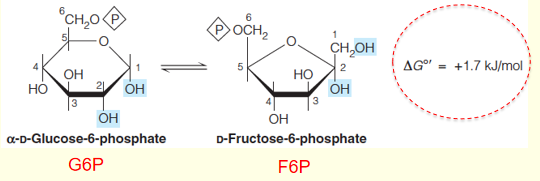
This isomerization reaction proceeds via an enediolate intermediate.
B: and B-H represent active-site amino acid residues acting as bases and acids, respectively.

3. Reaction 3: The Second Investment of ATP
Phosphofructokinase (PFK,磷酸果糖激酶) catalyzes a second ATP-dependent phosphorylation, to give a hexose derivative, fructose-1,6-bisphosphate (FBP), phosphorylated at both carbons 1 and 6.
Transferring the carbonyl oxygen from carbon 1 to carbon 2 has two important effects:
The hydroxyl group generated at carbon 1 can be readily phosphorylated in the reaction 3.
It also sets up the sugar for a symmetric aldol cleavage in reaction 4.
The phosphofructokinase reaction is the primary step at which glycolysis is regulated. 重要的反应,与调节密切相关

4. Reaction 4: Cleavage to Two Triose Phosphates
Fructose-1,6-bisphosphate aldolase(醛缩酶), catalyzes the “splitting of sugar” that is connoted by the term glycolysis.
The six-carbon sugar fructose-1,6-bisphosphate is cleaved to give 2 three-carbon intermediates, glyceraldehyde-3-phosphate (GAP,3-磷酸甘油醛) and dihydroxyacetone phosphate (DHAP,磷酸二羟基丙酮).
Aldolase cleaves fructose-1,6-bisphosphate under intracellular conditions, even though the equilibrium lies far toward fructose-1,6-bisphosphate under standard conditions.
↑ 细胞外的反应条件与机体内不同,因此反应也可能有所影响

**Reaction mechanism for fructose-1,6-bisphosphate aldolase: **
A protonated Schiff base intermediate (iminium ion) occurs between the substrate and an active site lysine residue.
An aspartate residue facilitates the reaction via general acid–base catalysis.
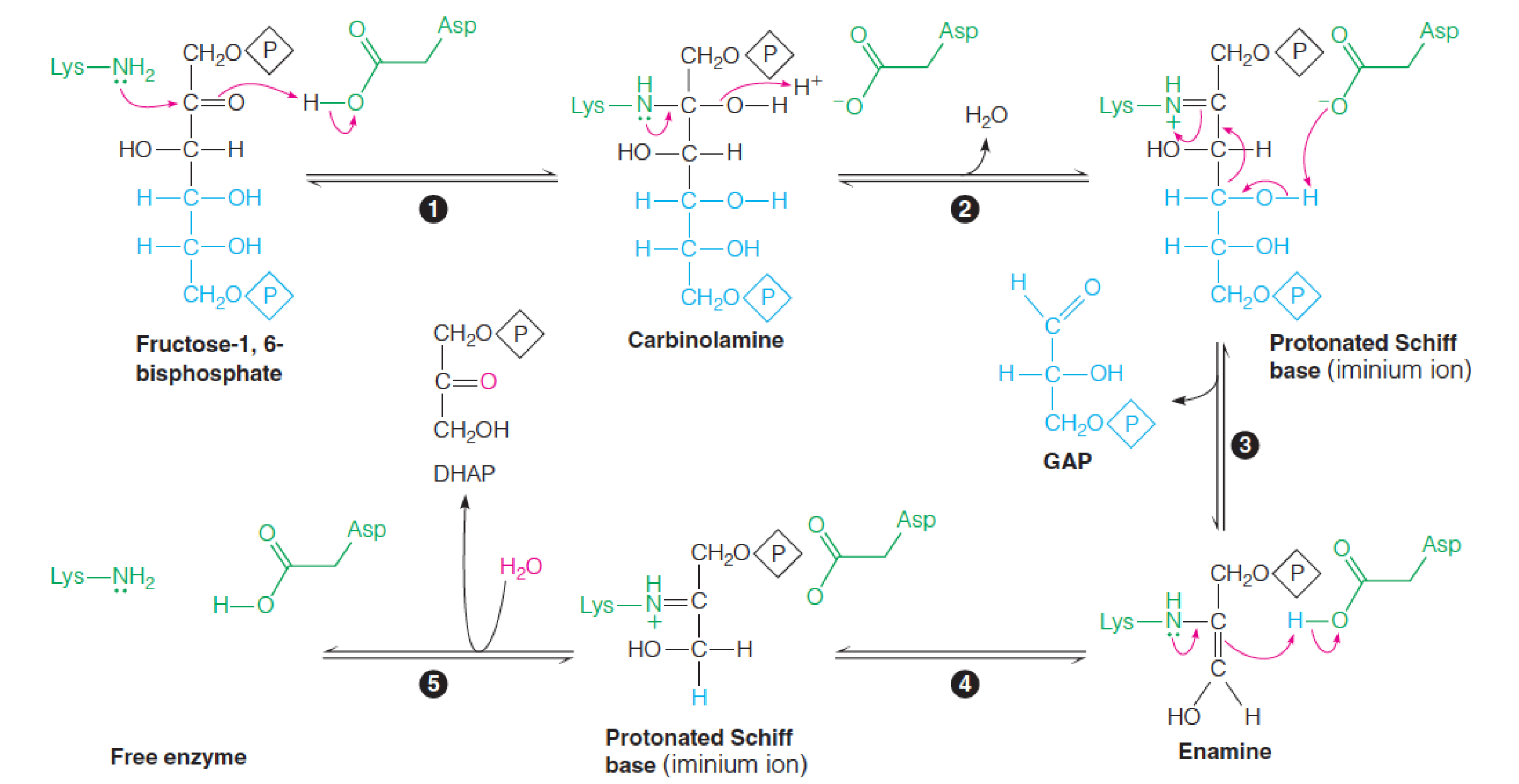
5. Reaction 5: Isomerization of Dihydroxyacetone Phosphate
The function of reaction 5, catalyzed by triose phosphate isomerase, is conversion of one of the products from reaction 4, dihydroxyacetone phosphate (DHAP), to the other, glyceraldehyde-3-phosphate (GAP).

The Last 5 Reactions: Energy Generation Phase
Reactions 6–10: The Energy Generation Phase(下图中的2上标,表示有两分子参与反应)

1 | |
1. Reaction 6: Generation of the First Energy-Rich Compound
This reaction, catalyzed by glyceraldehyde-3-phosphate (GAP) dehydrogenase, is among the most important in glycolysis, partly because it generates the first intermediate with high phosphate transfer potential and partly because it generates a pair of reducing equivalents.

The only Redox reaction in glycolysis.
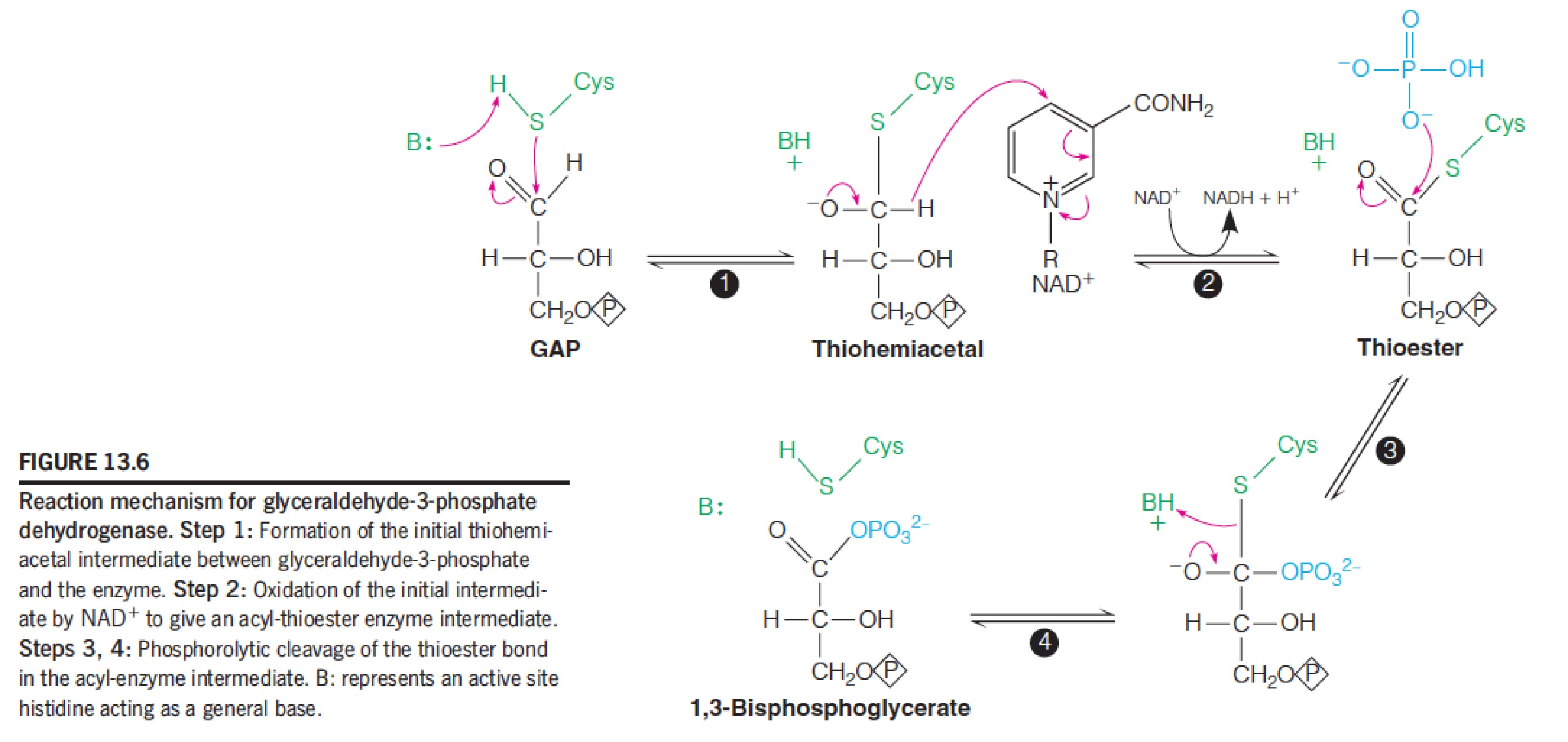
This mechanism conserves the energy of oxidation by coupling an exergonic reaction to an endergonic reaction:
脱氢的部分产能,这一部分能量在酶中基于磷酸化过程
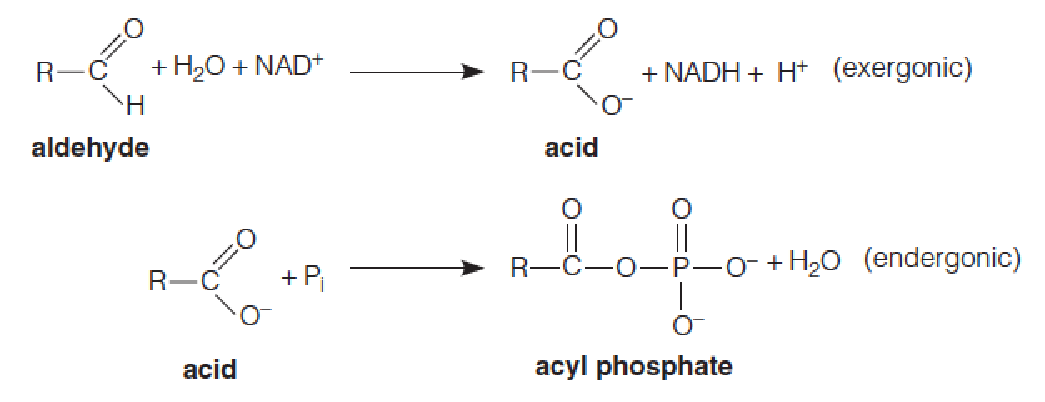
2. Reaction 7: The First Substrate-Level Phosphorylation
Because of its high phosphate transfer potential, 1,3-bisphosphoglycerate has a strong tendency to transfer its acyl-phosphate group to ADP, with resultant formation of ATP.
This substrate-level phosphorylation reaction is catalyzed by phosphoglycerate kinase.

Phosphoglycerate kinase catalyzes the first glycolytic reaction that forms ATP. (ADP作为底物接受高能磷酸基)
The glyceraldehyde-3-phosphate dehydrogenase and phosphoglycerate kinase are thermodynamically coupled:

3. Reaction 8: Preparing for Synthesis of the Next High-Energy Compound
Activation of 3-phosphoglycerate begins with an isomerization catalyzed by phosphoglycerate mutase(变位酶).
The enzyme transfers phosphate from position 3 to position 2 of the substrate to yield 2-phosphoglycerate.

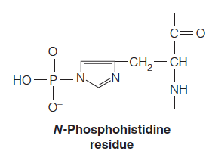
Reaction 8 is slightly endergonic under standard conditions.
However, the intracellular level of 3-phosphoglycerate is high relative to that of 2-phosphoglycerate (2PG), so that in vivo the reaction proceeds to the right without difficulty.
The enzyme contains a phosphohistidine residue in the active site.
In the first step of the reaction, the phosphate is transferred from the enzyme to the substrate to give an intermediate, 2,3 bisphosphoglycerate.
Transfer of the phosphate from C-3 to the active site of the enzyme regenerates the phosphorylated enzyme and forms the product, which is released.

4. Reaction 9: Synthesis of the Second High-Energy Compound
Reaction 9, catalyzed by enolase, generates phosphoenolpyruvate (PEP), another compound with very high phosphate transfer potential.
PEP participates in the second substrate-level phosphorylation of glycolysis.
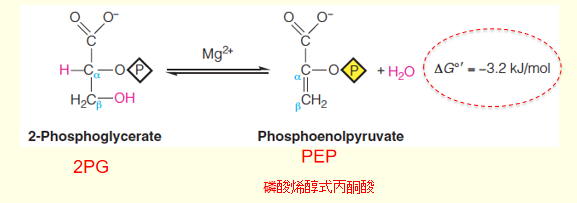
5. Reaction 10: The Second Substrate-Level Phosphorylation
In the last reaction, catalyzed by pyruvate kinase (PK,丙酮酸激酶), phosphoenolpyruvate transfers its phosphoryl group to ADP in another substrate-level phosphorylation.
Note that the enzyme is named as if it were acting leftward in the reaction shown below, even though it is strongly exergonic in the rightward direction.
Many enzymes were named before the function or direction of intracellular catalysis had been identified.

三、Metabolic Fates of Pyruvate
The reaction mechanism of pyruvate kinase:
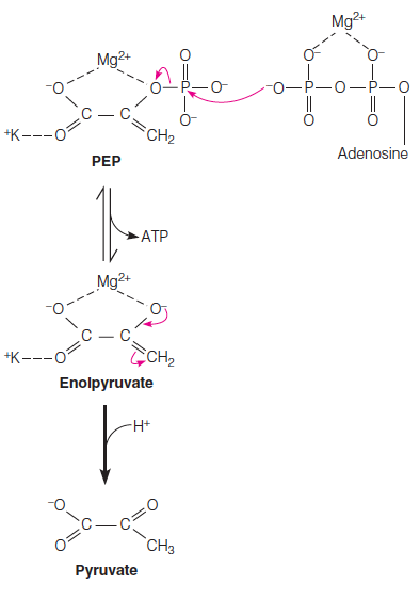
Pyruvate kinase (PK) is another site for metabolic regulation.
PK, like many enzymes, exists in animal tissues as multiple isozymes.
Mammals carry two paralogous(串列的) pyruvate kinase genes, which, through alternative splicing, produce four different PK isozymes.
All four PK isozymes are homotetramers of 60 kDa subunits, and except for the M1 isozyme, require allosteric activation by fructose-1,6-bisphosphate for full activity.
The L and R isozymes are allosterically inhibited at high ATP concentrations.
The M1 isozyme, on the other hand, is constitutively active.
Dietary carbohydrate induces the biosynthesis of pyruvate kinase and increases the ability of the body to obtain energy from glycolysis.
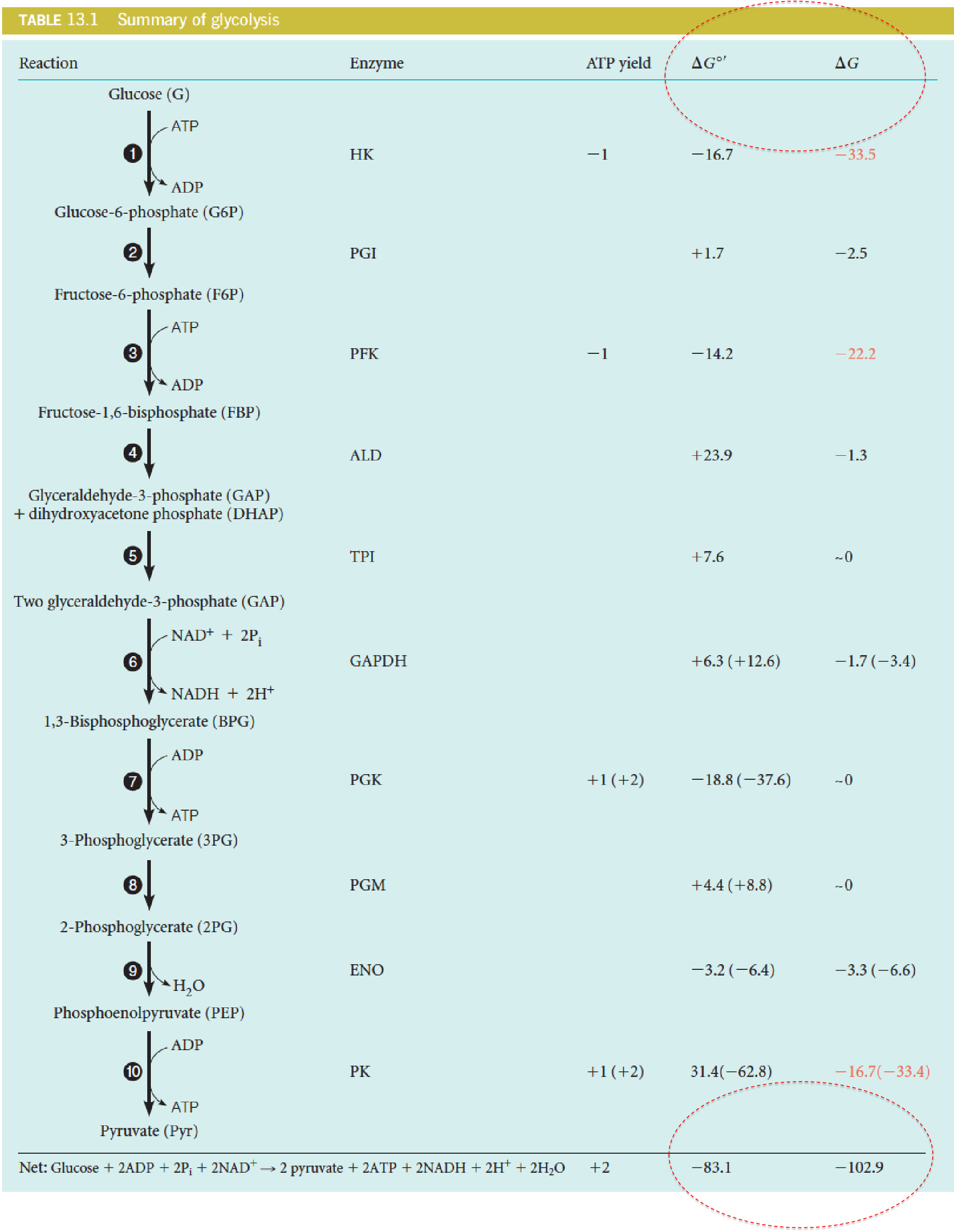
在细胞内部反应 (-102.9)相比于标准条件下 (-83.1)更容易进行(对比$\Delta G^{\circ \prime},\Delta G$)
Pyruvate represents a central metabolic branch point.
Its fate depends crucially on the oxidation state of the cell, which is related to the reaction catalyzed by glyceraldehyde-3-phosphate (GAP) dehydrogenase (reaction 6).
Recall that this reaction converts 1 mole of NAD+ per mole of triose phosphate to NADH.
The cytoplasm has a finite supply of NAD+ so this NADH must be reoxidized to NAD+ for glycolysis to continue.
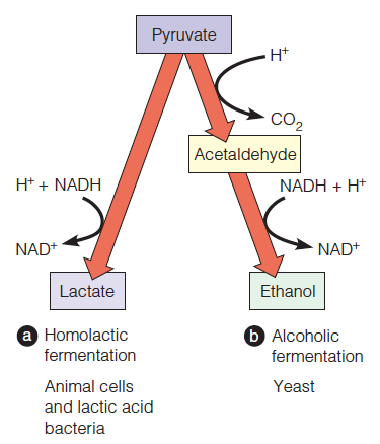
Pyruvate must be reduced to lactate when tissues are insufficiently aerobic to oxidize all of the NADH formed in glycolysis.
Microorganisms can oxidize NADH via fermentations producing lactate or ethanol.
1. Animal cells
Aerobic glycolysis:
1)pyruvate →acetyl-CoA →citric acid cycle → 15 ATP;
2) cytoplasic NADH →mitochondrial electron transport chain → O2 → 2.5 or 1.5 ATP;
Anaerobic glycolysis :
RBC (Red Blood Cell): derive most of their energy from anaerobic glycolysis;
Skeletal muscle: during exertion, pyruvate →lactate (NADH → NAD+); Lactate is an intermediate rather than “dead end” (too much lactate reduces blood pH)
2) Lactate (muscle)→blood → liver → glucose →muscle (Cori cycle)
3) Lactate (muscle) →heart →pyruvate (LDH)→acetyl-CoA →citric acid cycle → ATP for heart
2. Yeast converts pyruvate to ethanol in a two-step pathway
This alcoholic fermentation starts with the nonoxidative decarboxylation of pyruvate to acetaldehyde, catalyzed by pyruvate decarboxylase.
NAD+ is regenerated in the next reaction, the NADH-dependent reduction of acetaldehyde to ethanol, catalyzed by alcohol dehydrogenase.

Ethanol intoxication
- deplete NAD+, reduces flux from GAP dehydrogenase reaction and glycolysis;
- Acetaldehyde is quite toxic.
乙醇脱氢酶把乙醇氧化成乙醛(这个过程消耗NAD+,即生成乙醇的逆反应);乙醛脱氢酶把乙醛变成乙酸
如果乙醛脱氢酶无法及时将乙醛转化,乙醛的毒性就会对身体造成影响,可能致癌
The first reaction requires thiamine(硫铵素) pyrophosphate (TPP) as a coenzyme.
The vitamin is structurally complex, but its conversion to the coenzyme form, thiamine pyrophosphate, or TPP, involves simply an ATP-dependent pyrophosphorylation.
Thiamine pyrophosphate (TPP) is the coenzyme for all decarboxylations of α-keto acids.
Unlike β-keto acids, α-keto acids cannot stabilize the carbanion transition state that develops during decarboxylation, and they thus require the aid of a cofactor (TPP).
The thiazole ring of TPP is the functional part of the coenzyme, allowing it to bind and transfer activated aldehydes.

Because the thiazole ring is weakly acidic (pKa ~ 18 for the ring hydrogen), a general base is required in its ionization.
As shown in the following diagram, a glutamate carboxyl group in the enzyme deprotonates N-1 of the pyrimidine, which in turn increases the basicity of the amino group, facilitating the deprotonation of C-2 of the thiazole ring to give a dipolar thiazolium carbanion (or ylid).

Thiamine pyrophosphate in the pyruvate decarboxylase reaction:
The key reaction (step 2) is attack by the carbanion of TPP on the carbonyl carbon of pyruvate and is followed by nonoxidative decarboxylation of the coenzyme-bound pyruvate to give another carbanion (step 3), which is resonance-stabilized.
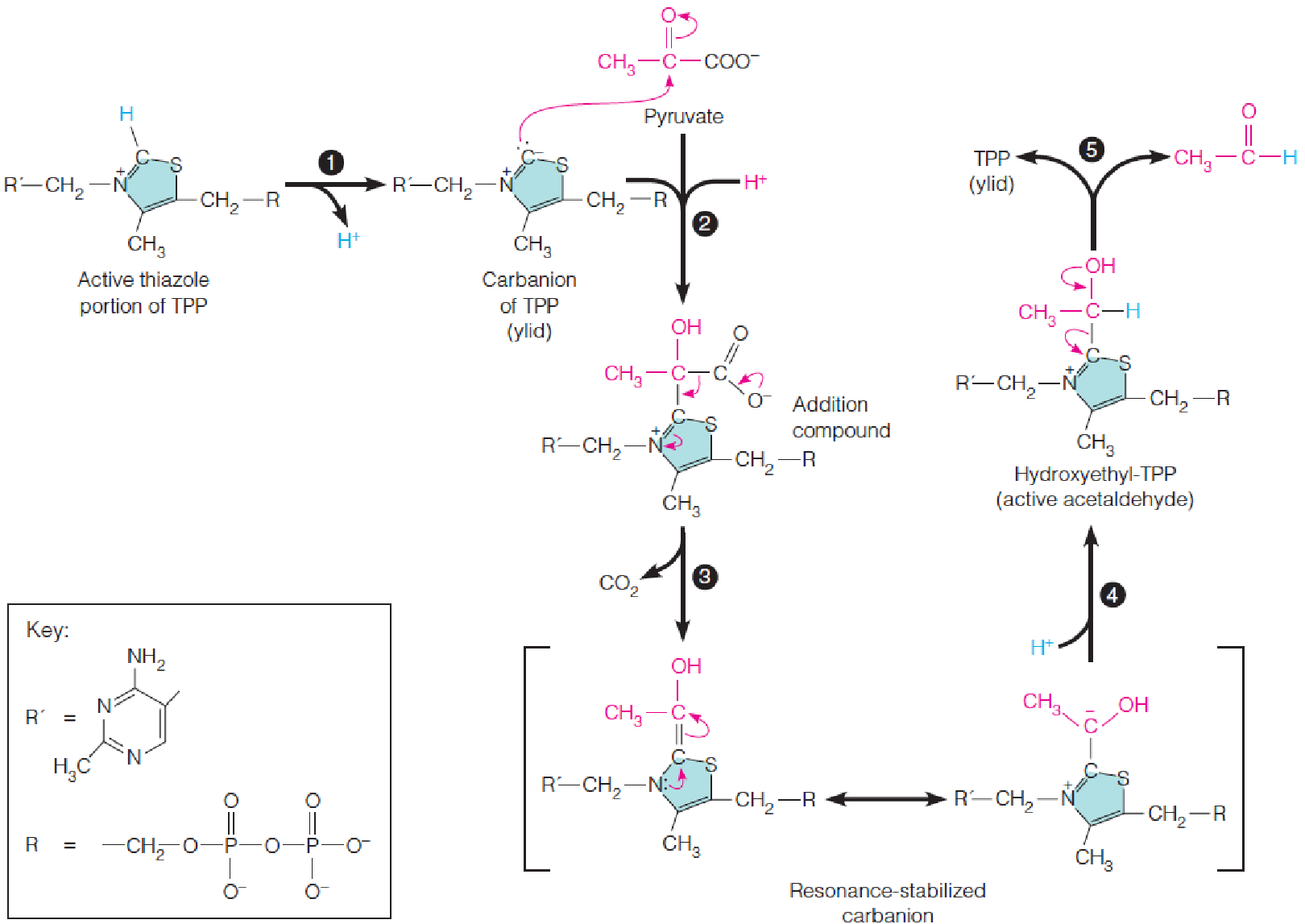
四、Energy and Electron Balance Sheets
Glycolysis, which yields 2 ATP per glucose, is fast but releases only a small fraction of the energy available from glucose.(100 times faster than aerobic oxidation phosphorylation)
Glycosis的优势和重要性在于速度快
In alcoholic fermentation as in lactate fermentation, an exergonic process coupled to an endergonic process. (Muscle cells, cancer cell)

只有27%的能量转变为ATP,剩余的能量转变为热能释放。
Industrial production of ethanol; replacement of non-renewable petroleum:
Bioengineering bacterial strains: cellulose (waste wood)→ hexose sugar → ethanol
Concern: technical hurdles, water demand; green emission
Energy profile of anaerobic glycolysis
Most of the reactions function at or near equilibrium and are freely reversible in vivo.
The three enzymes that catalyze reactions so highly exergonic as to be virtually irreversible (arrows) are subject to allosteric control.
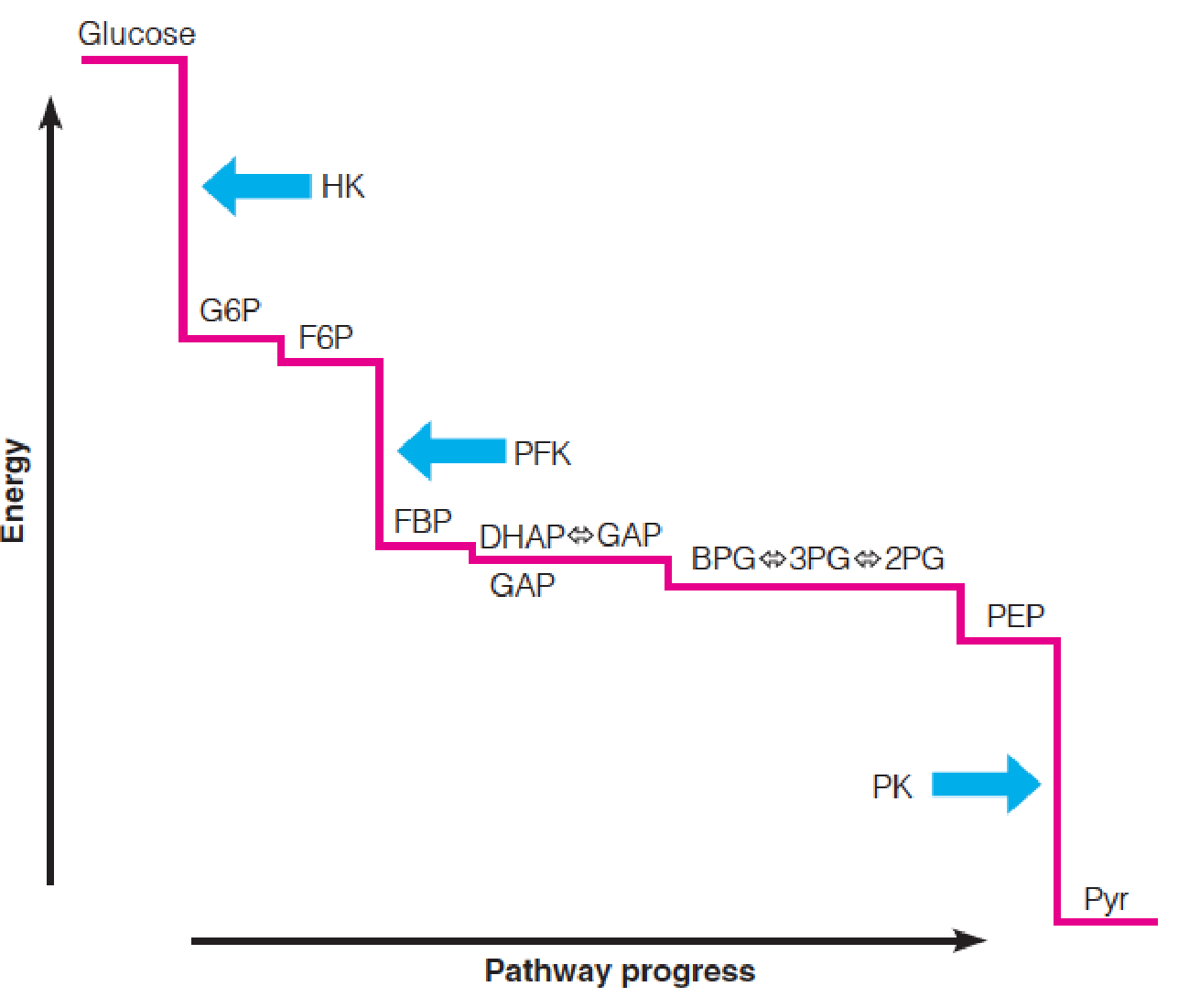
1 | |
五、Gluconeogenesis
1. Synthesis and use of glucose in the human body
Liver and kidney cortex are the primary gluconeogenic tissues. (糖异生的主要器官在肝脏)
Brain, skeletal muscle, kidney medulla, erythrocytes, and testes use glucose as their sole or primary energy source, but they lack the enzymatic machinery to synthesize it.
Synthesis of glucose from noncarbohydrate precursors is essential for maintenance of blood glucose levels within acceptable limits.
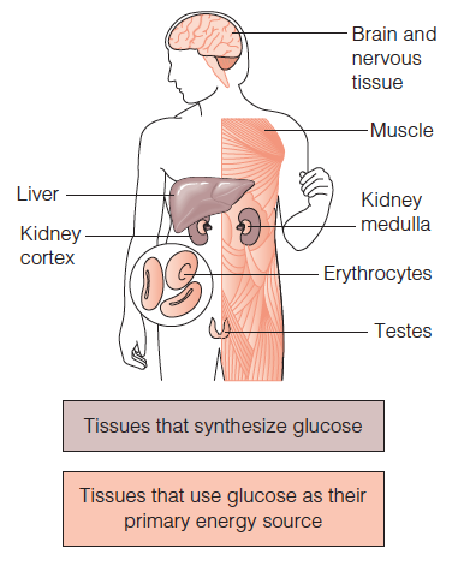
Gluconeogenesis uses specific enzymes to bypass three irreversible reactions of glycolysis.
Reactions of glycolysis and gluconeogenesis
Irreversible reactions of glycolysis are shown in dark purple.
The opposed reactions in gluconeogenesis, which bypass these steps, are shown in dark blue.
Pale arrows identify reversible reactions used in both pathways.
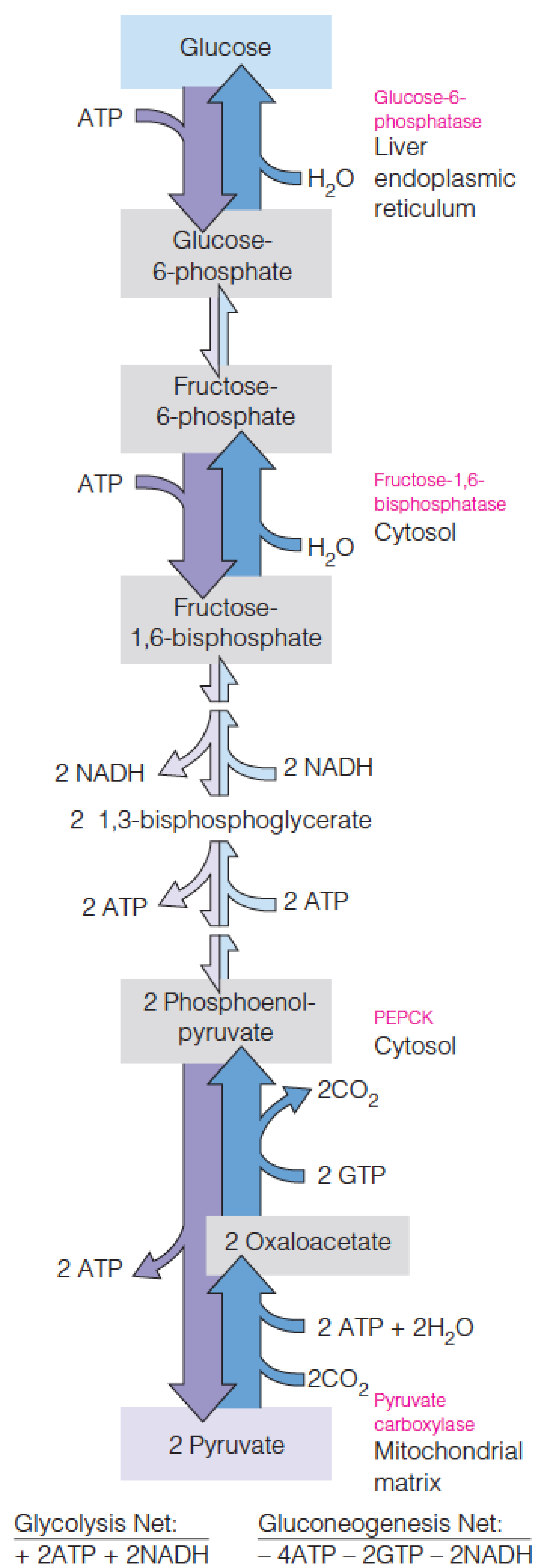
1. Bypass 1: Conversion of Pyruvate to Phosphoenolpyruvate (PEP)
The bypass of pyruvate kinase begins in the mitochondrion and involves two reactions.
Pyruvate carboxylase (PC,丙酮酸羧化酶) catalyzes the ATP- and biotin-dependent conversion of pyruvate to oxaloacetate.
The enzyme requires acetyl-CoA as an allosteric activator:

To be used for gluconeogenesis, oxaloacetate(草酰乙酸) must move out of the mitochondrion to the cytosol, where the remainder of the pathway occurs.
However, the mitochondrial membrane does not have an effective transporter for oxaloacetate.
Therefore, oxaloacetate is reduced by mitochondrial malate dehydrogenase to malate(苹果酸), which is transported into the cytosol by exchange for orthophosphate and then reoxidized by cytosolic malate dehydrogenase(苹果酸脱氢酶).
Once in the cytosol, oxaloacetate is acted on by phosphoenolpyruvate carboxykinase (PEPCK) to give phosphoenolpyruvate:
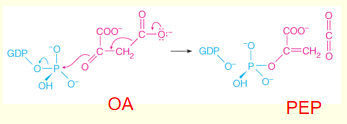
2. Bypass 2: Conversion of Fructose-1,6-bisphosphate (FBP) to Fructose-6-phosphate
The PFK reaction of glycolysis is essentially irreversible, but only because it is driven by phosphate transfer from ATP.
A bypass reaction in gluconeogenesis involves a simple hydrolytic reaction, catalyzed by fructose-1,6- bisphosphatase (FBPase).
3. Bypass 3: Conversion of Glucose-6-phosphate (G6P) to Glucose
Glucose-6-phosphate cannot be converted to glucose by reverse action of hexokinase or glucokinase because of the high positive $\Delta G ^{\circ}$ of that reaction; phosphate transfer from ATP makes that reaction virtually irreversible.
Another enzyme specific to gluconeogenesis, glucose-6-phosphatase (G6Pase), also involves a simple hydrolysis.
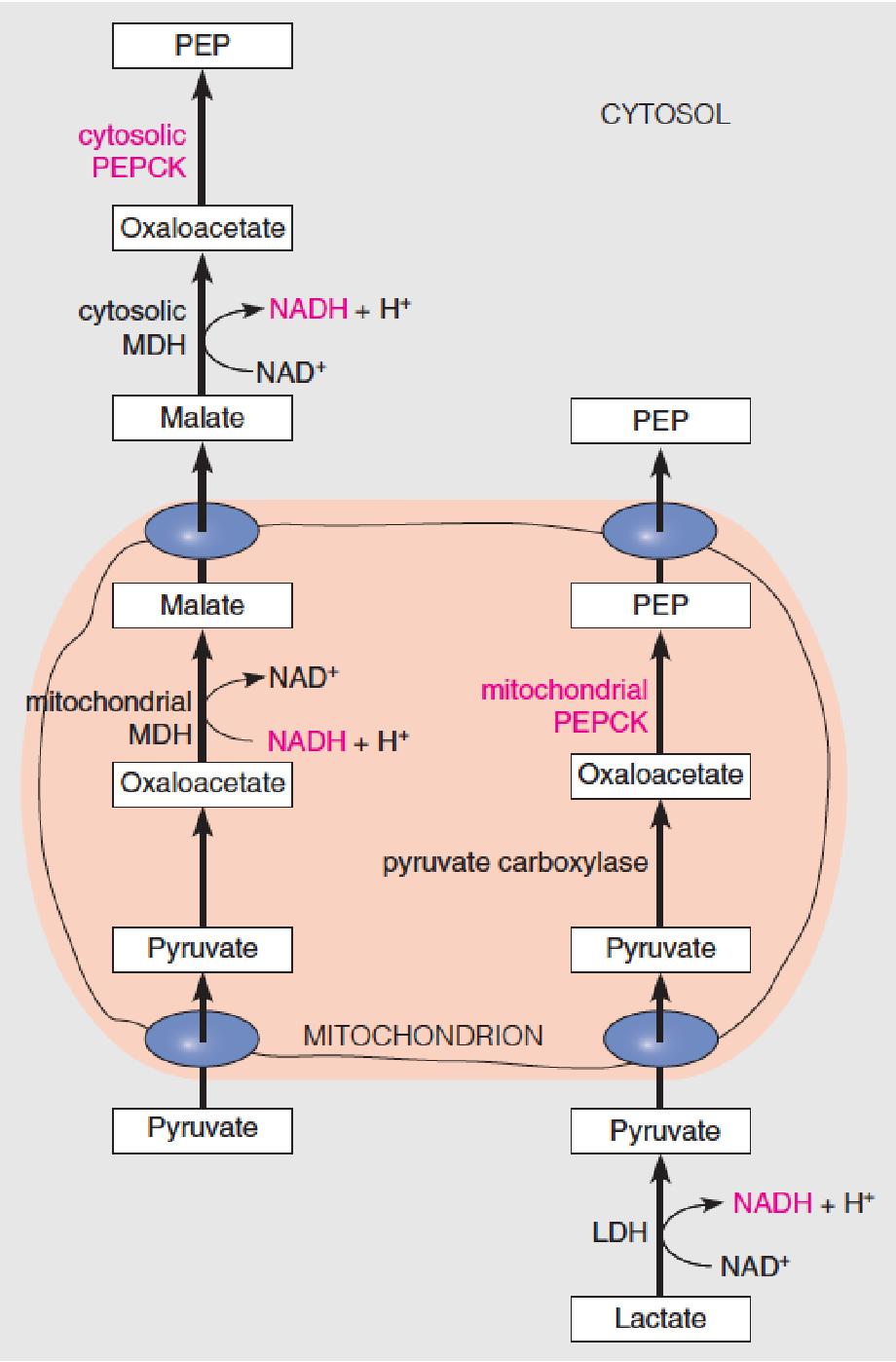
PEPCK isozymes provide alternative routes to PEP and cytoplasmic reducing equivalents:
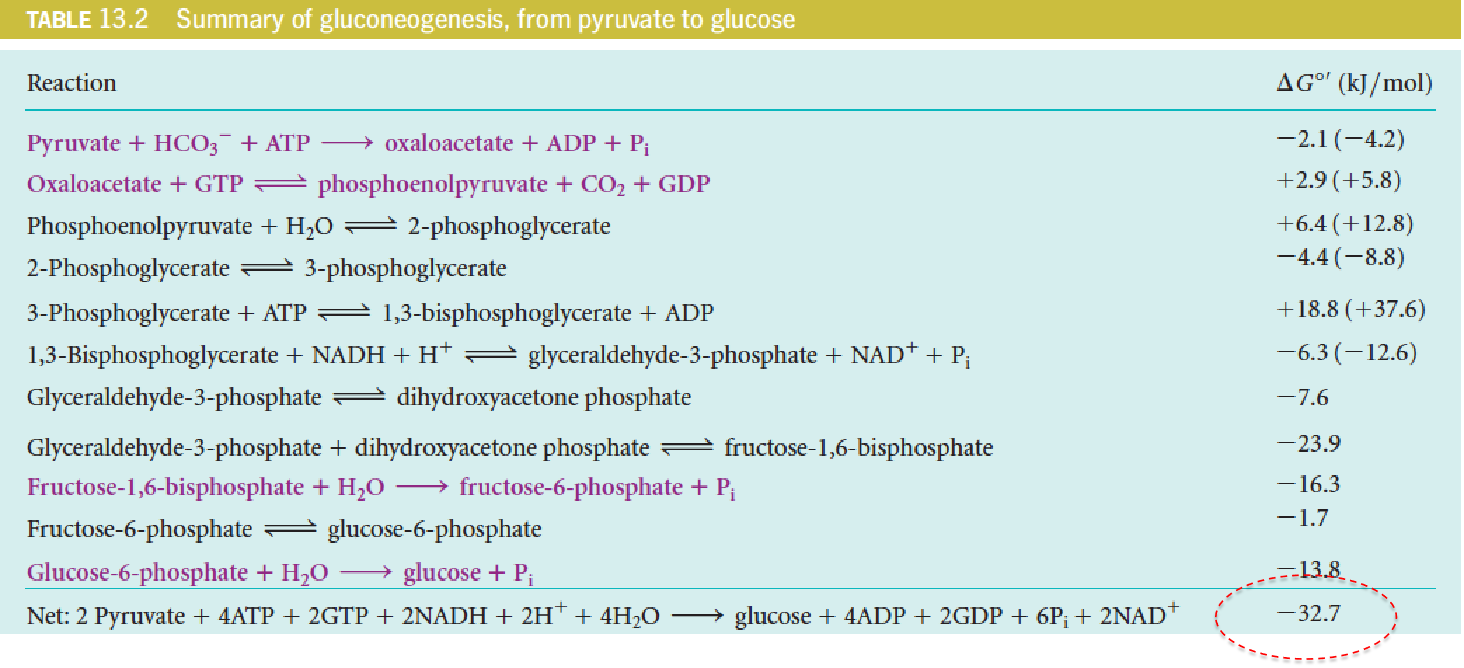
Six high-energy phosphate group (4ATP+2GTP)
2NADH→ electron transport chain→ 5 ATP
So, it is very energetically expensive process!
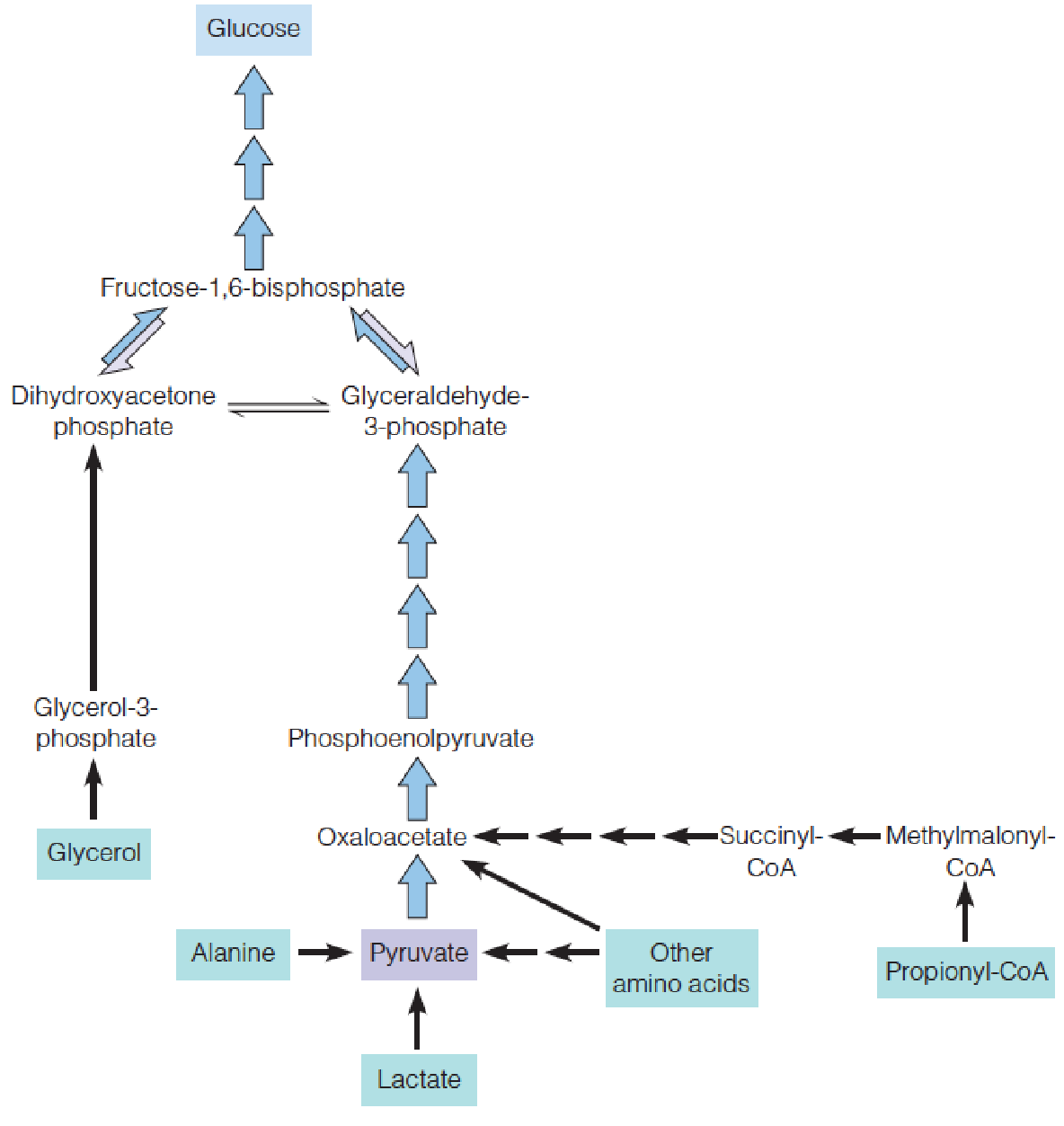
Outline of pathways for glucose synthesis from the major gluconeogenic precursors:
Note that both glucose and lactate are carried in the blood.
The equivalent of 11 high-energy phosphates(4+2+2*2.5) are consumed per mole of glucose synthesized by gluconeogenesis.
The most important gluconeogenic precursors are lactate, alanine(丙氨酸(蛋白代谢)), glycerol(甘油(脂肪代谢)), and propionate(丙酸(脂肪代谢)).
Animals cannot undergo net conversion of fat to carbohydrate.
- However, 脂肪里面的甘油部分可以变成糖
The Cori cycle
Lactate produced in glycolysis during muscle exertion is transported to the liver, for resynthesis of glucose by gluconeogenesis.
Transport of glucose back to muscle for synthesis of glycogen, and its reutilization in glycolysis, completes the cycle.
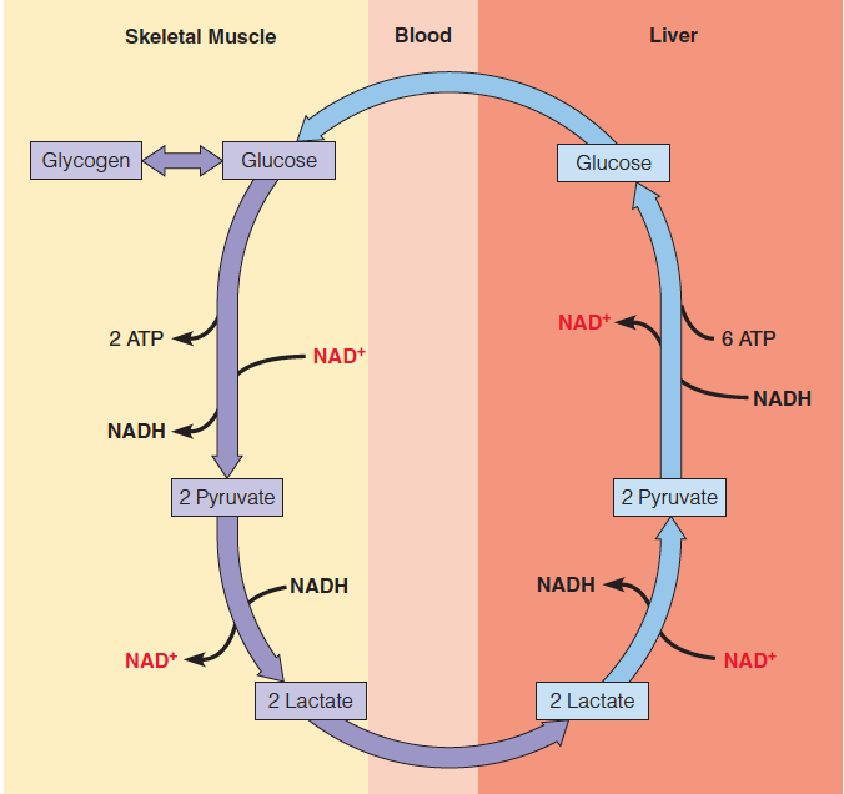
In all organisms a three-carbon acyl-CoA, propionyl-CoA, is generated either from the breakdown of some amino acids or from the oxidation of fatty acids with odd numbers of carbon atoms.
- 机体内的大多数脂肪酸都是双数碳(Even Number),原因是合成的时候使用了乙酰辅酶A
- 偶数碳的脂肪酸无法变成糖,但是少数的奇数碳的脂肪酸经过一系列反应可以变成糖
Propionyl-CoA enters gluconeogenesis via its conversion to succinyl-CoA and then to oxaloacetate.
The process involves a coenzyme derived from vitamin B12.

六、Coordinated Regulation of Glycolysis and Gluconeogenesis
Louis Pasteur observed that when anaerobic yeast cultures metabolizing glucose were exposed to air, the rate of glucose utilization decreased dramatically.
It became clear that this phenomenon, known as the Pasteur effect, involves the inhibition of glycolysis by oxygen.
This effect makes biological sense because far more energy is derived from complete oxidation of glucose than from glycolysis alone.
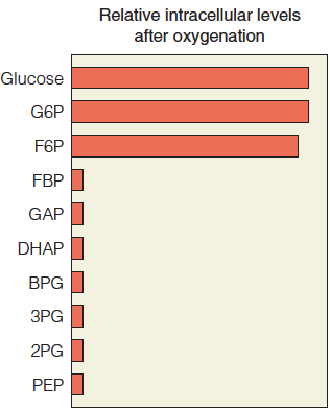
1 | |
Periodic oscillations of the levels of glycolytic intermediates in yeast cells undergoing glycolysis
The culture was shifted from aerobic to anaerobic conditions at the point labeled “Air off.”
The upper tracing depicts continuous monitoring of fluorescence of the cell suspension, which is related to the intracellular concentration of NADH.
The nucleotide levels were determined in a parallel experiment in which samples of culture were removed at various times, extracted, and assayed for their contents of ATP, ADP, and AMP
1 | |
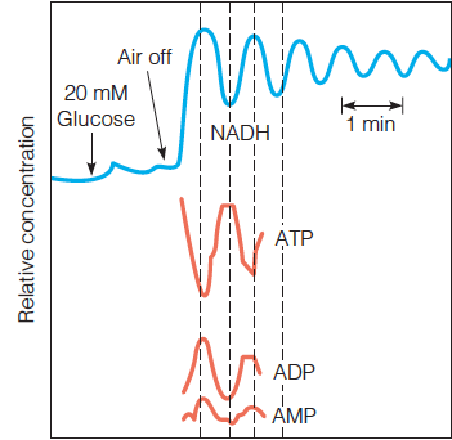
Alternative fates of glycolytic intermediates in biosynthetic pathways:
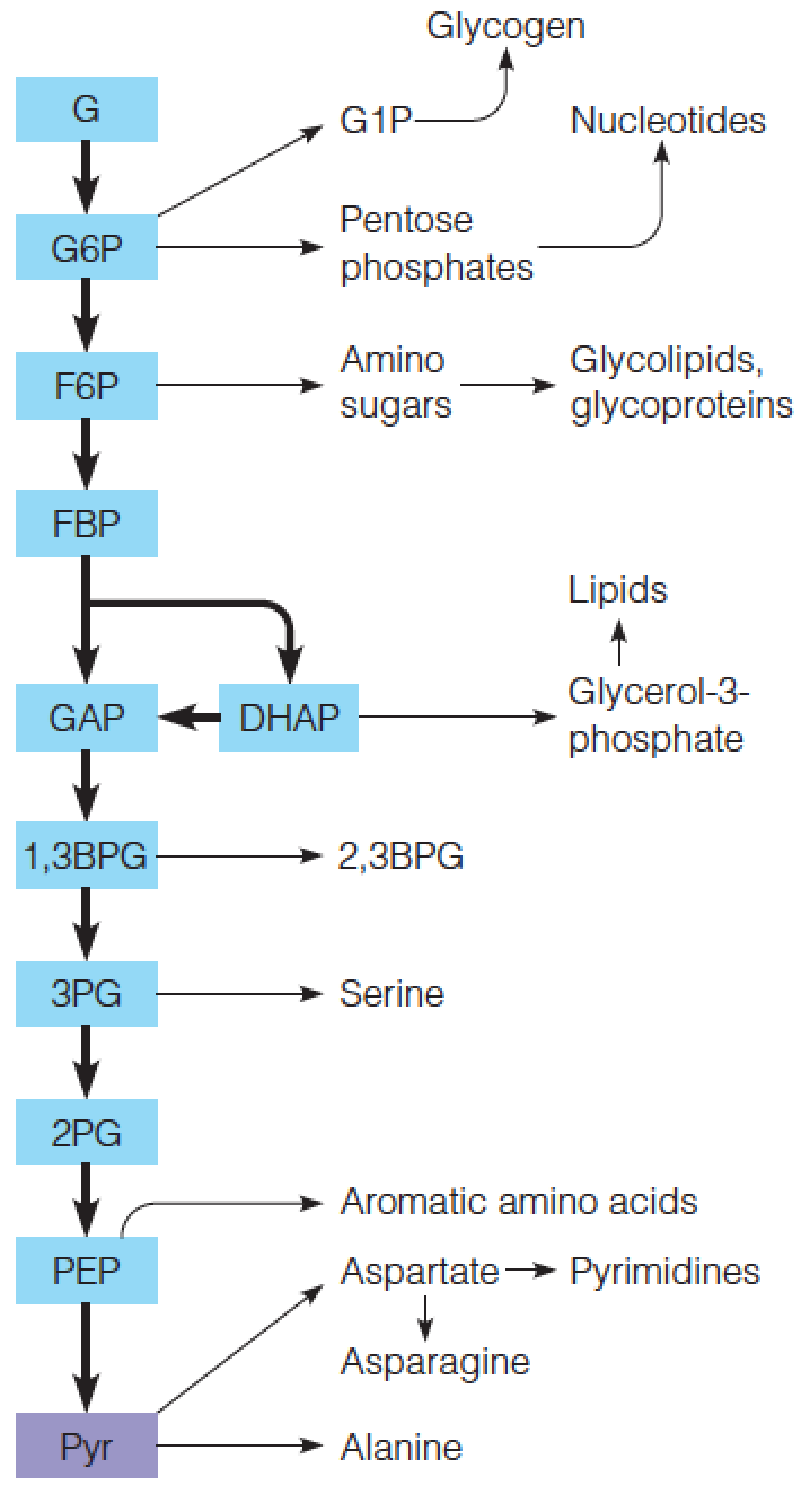
Comparative substrate cycles in glycolysis/gluconeogenesis
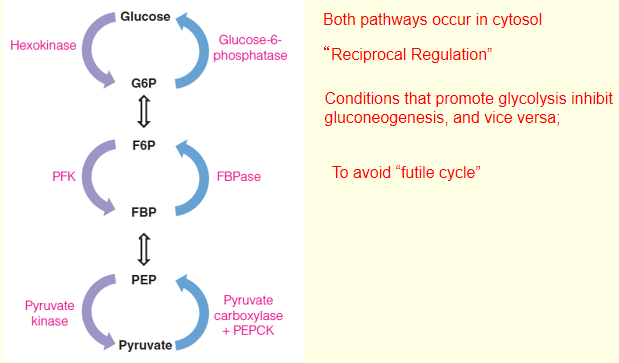
Major control mechanisms affecting glycolysis and gluconeogenesis
Note the strongly exergonic reactions of glycolysis and gluconeogenesis and the major activators and inhibitors of these reactions.
Low energy charge→activates rate-limiting steps in glycolysis (HK, PFK and PK);
High energy charge→inhibits rate-limiting steps in glycolysis (HK, PFK and PK) ;
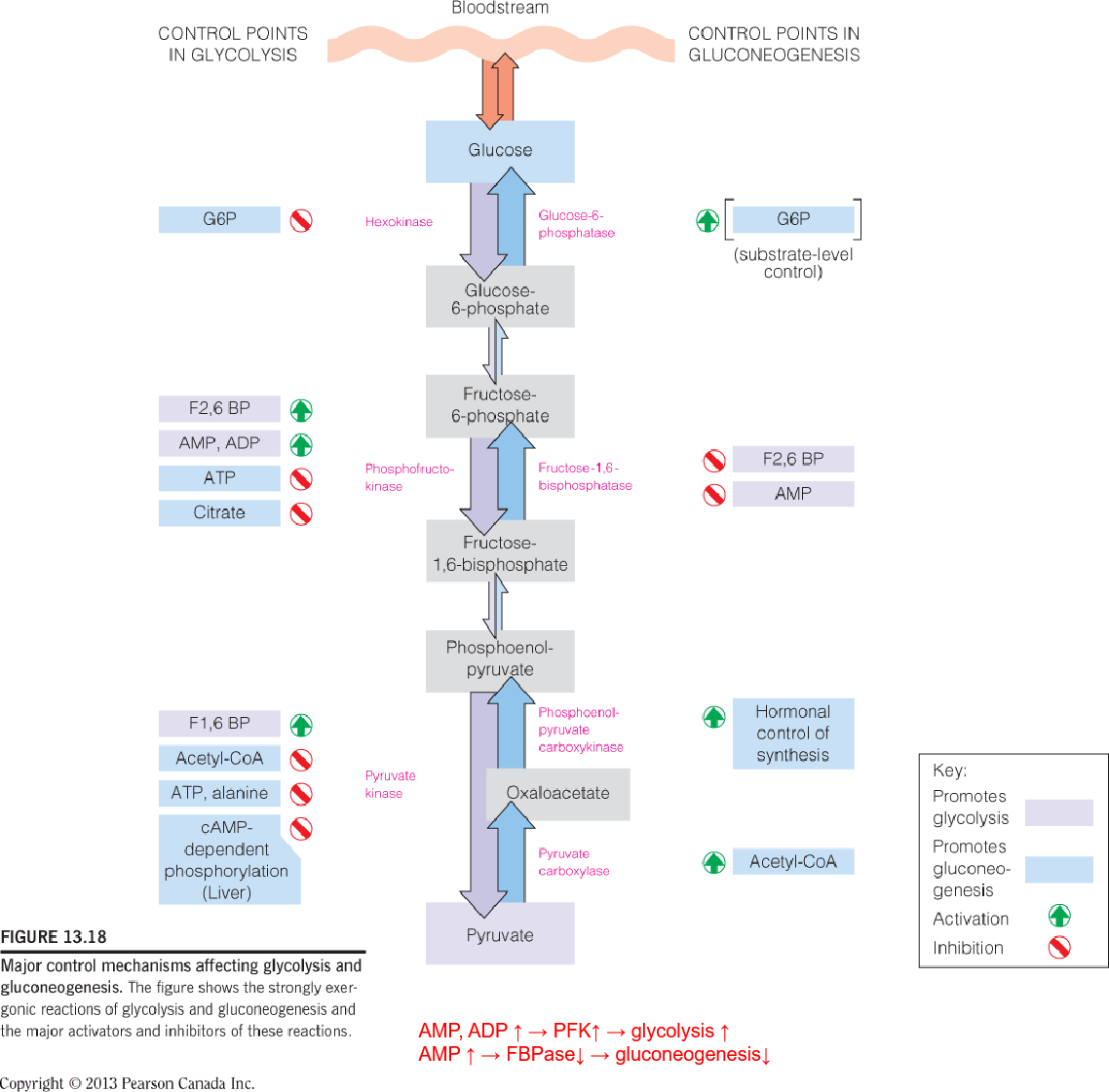
Fructose-2,6-bisphosphate (F2,6BP,果糖2,6 双磷酸) is the most important regulator of glycolysis and gluconeogenesis.
It is synthesized and degraded by different forms of the same enzyme.
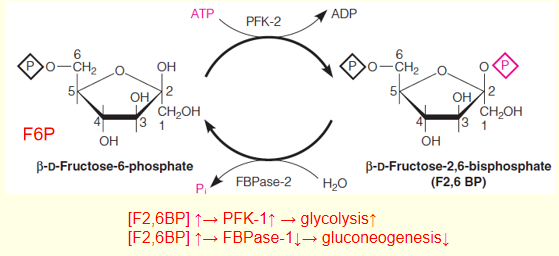
1. Allosteric control of liver PFK
- Activation by fructose-2,6-bisphosphate. (被F-2,6-BP activate)
- How ATP increases the apparent K
Mfor substrate fructose-6-phosphate. ATP浓度上升,对F6P的亲和力下降,即抑制酶的活性 - Model of E. coli PFK homotetramer.
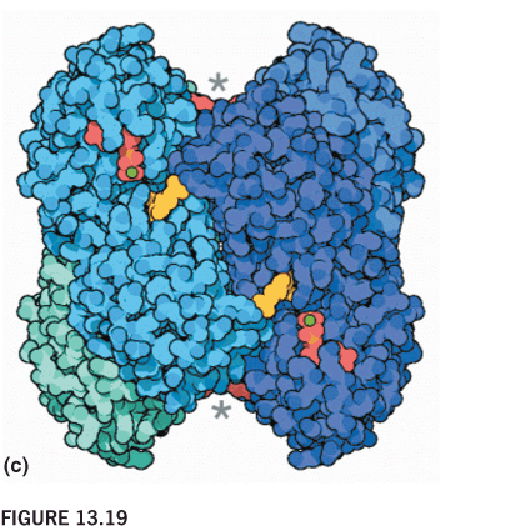
2. Bifunctional PFK-2/FBPase-2
The X-ray crystal structure of one subunit of the homodimeric human liver enzyme
The kinase active site is marked by a bound nonhydrolyzable ATP analog.
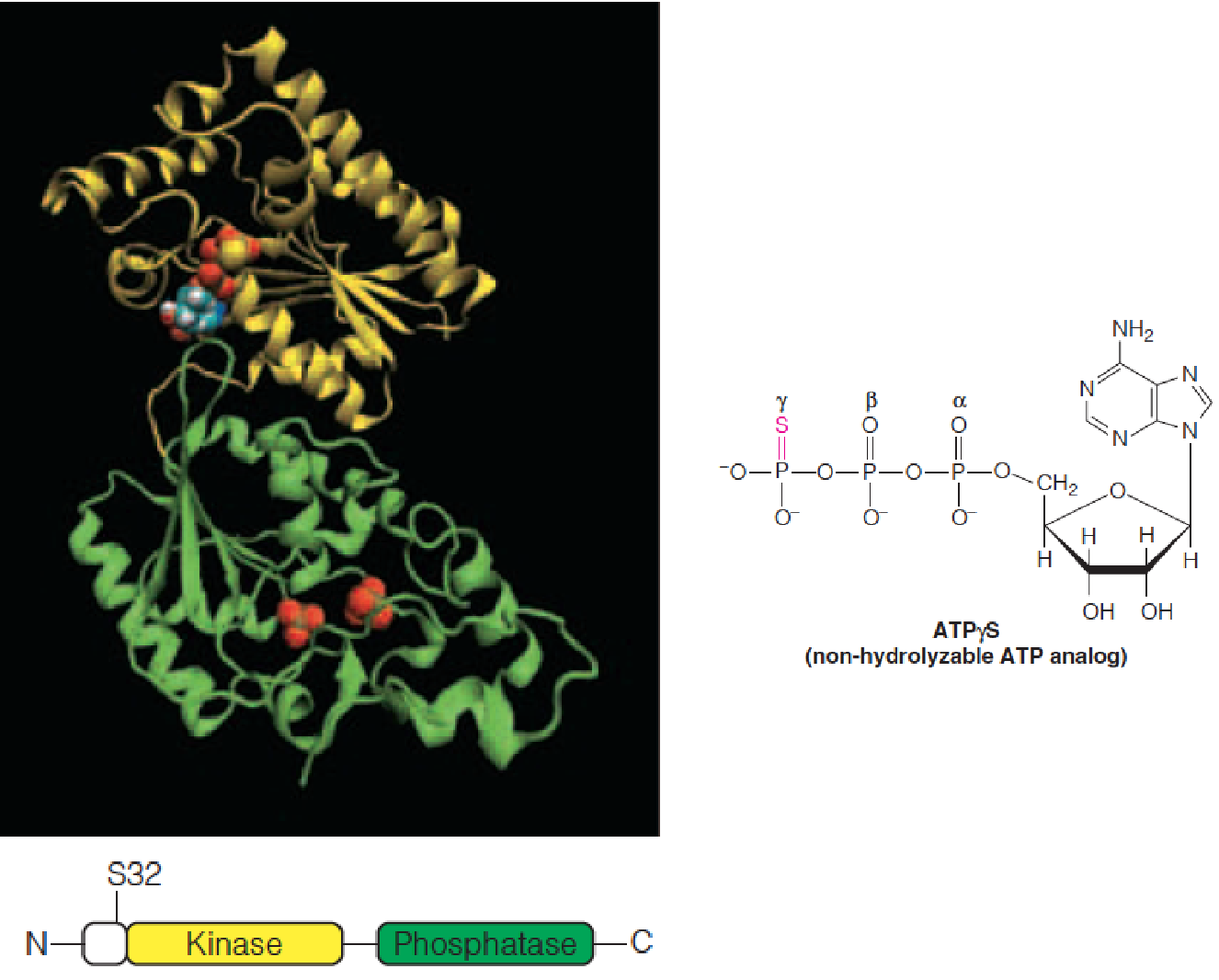
同时具有PFK,FBPase的活性
Regulation of the synthesis and degradation of fructose-2,6-bisphosphate in liver
The bifunctional PFK-2/FBPase-2 is controlled by reversible phosphorylation of a specific serine residue near the N-terminus of each subunit of the homodimeric protein.
In the unphosphorylated form, the 6-phosphofructo-2-kinase domain (K) is active, and fructose-2,6-bisphosphate (F2,6BP) is synthesized.
In the phosphorylated form, the fructose-2,6-bisphosphatase domain (B) is active, and F2,6BP is degraded.
Glucagon(胰高血糖素) stimulates phosphorylation by activating cAMP-dependent protein kinase (PKA).
Insulin and glucose (via xyulose-5-phosphate) stimulate dephosphorylation by activating a protein phosphatase. (使得Kinase活性激活,对glucose的利用加快,从而使得血糖浓度下降)
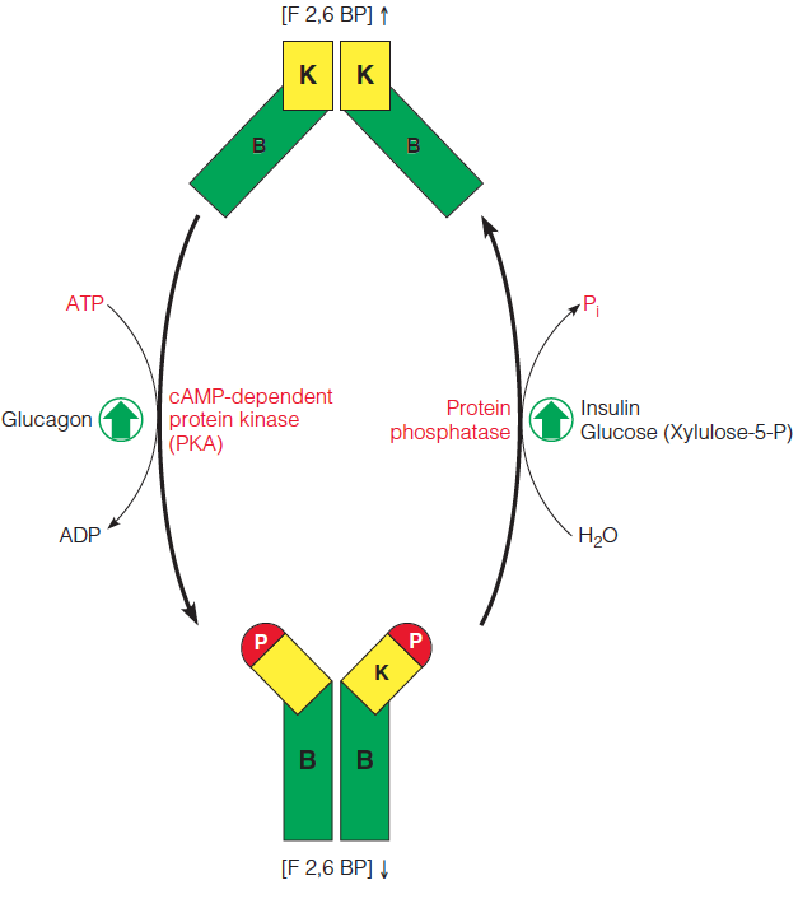
Glucagon→ receptor (GPCR)→cAMP → PKA →PFK-2/FBPase-2 phosphorylation →FBPase-2 activity↑→ [F2,6BP]↓ → PFK-1↓ →glycolysis ↓ →blood glucose level ↑
Insulin →PFK-2/FBPase-2 dephosphorylation →PFK-2 kinase activity ↑ → [F2,6BP] ↑ → PFK-1 ↑ →glycolysis ↑ →blood glucose level ↓
3. Regulation of liver hexokinase by protein–protein interactions
Activity of the liver hexokinase isozyme IV (HKIV) is regulated by alternative protein–protein interactions with the glucokinase regulatory protein (GKRP) in the nucleus and dephosphorylated PFK- 2/FBPase-2 in the cytoplasm.
Insulin binding to its plasma membrane receptor stimulates dephosphorylation of PFK-2/FBPase-2.
Glut2, plasma embrane glucose transporter.
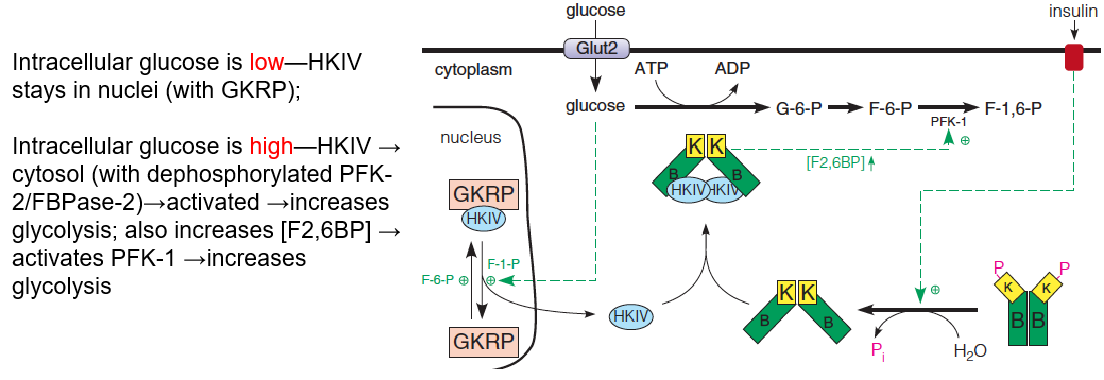
八、Entry of Other Sugars into the Glycolytic Pathway
Routes for utilizing substrates other than glucose in glycolysis
In animals, most of the carbohydrate other than glucose and glycogen comes from the diet, and most of the glycerol is derived from lipid catabolism.
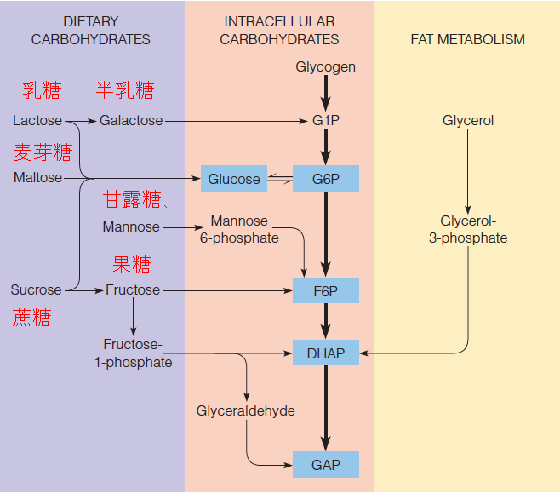
Leloir pathway for utilizing galactose by converting it to glucose-6-phosphate
The galactose and glucose rings are colored blue and orange, respectively, to emphasize that reaction 3 is a group transfer, not an epimerization(差向异构).
Recall that glucose and galactose are epimers at C-4.
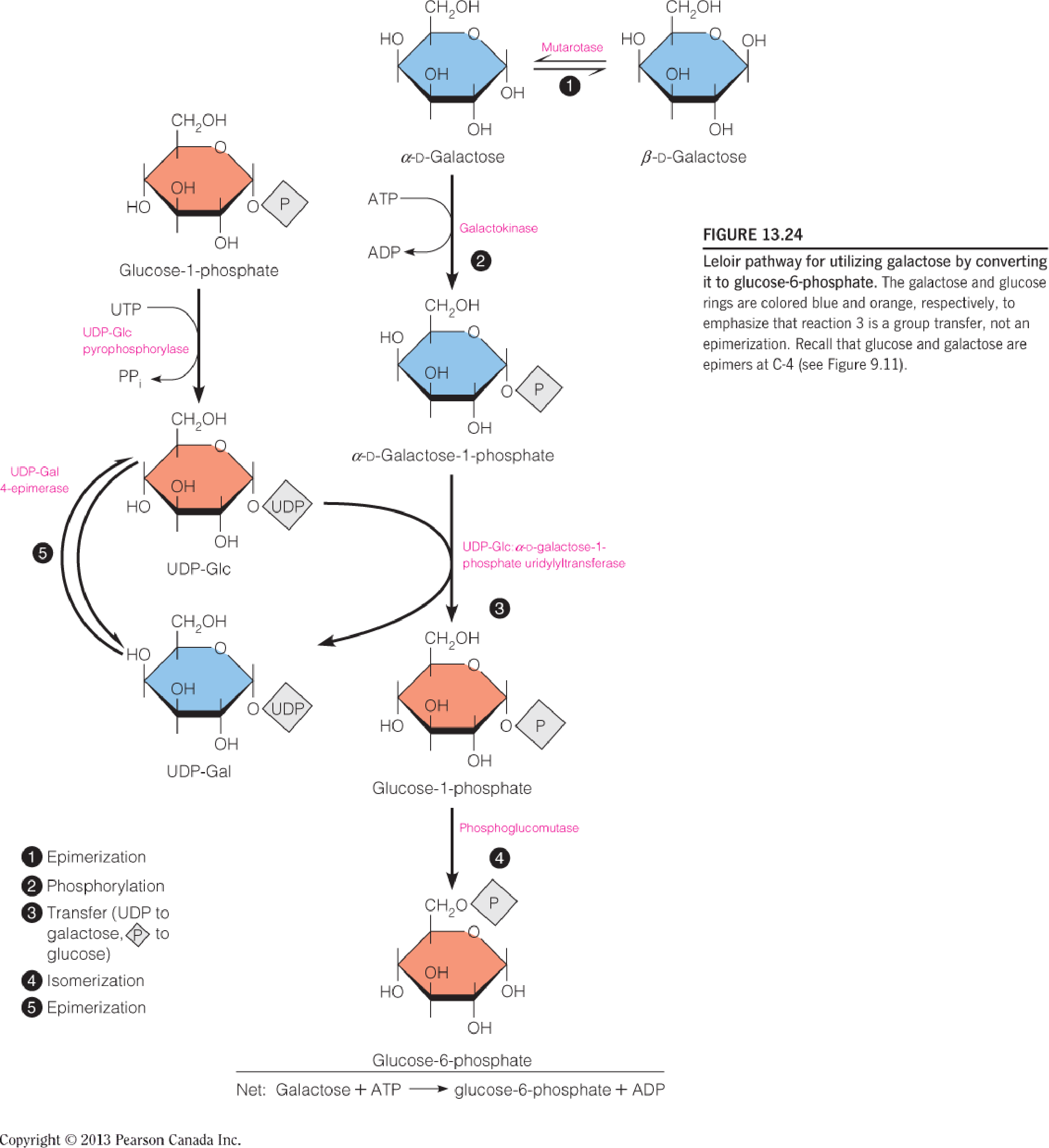
Maltose, lactose, Surcose and Fat
The three disaccharides most abundant in foods are maltose, lactose, and sucrose
Maltose is available primarily as an artificial sweetener, derived from starch, while lactose and sucrose are abundant natural products.
In animal metabolism they are hydrolyzed in cells lining the small intestine, to give the constituent hexose sugars:
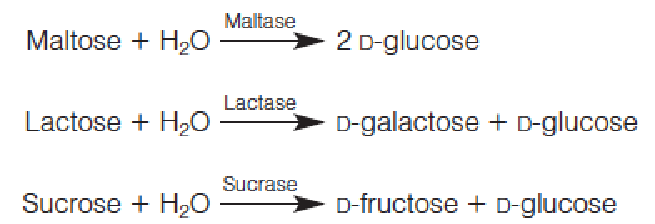
Asian lactose intolerance: lactase in their intestines
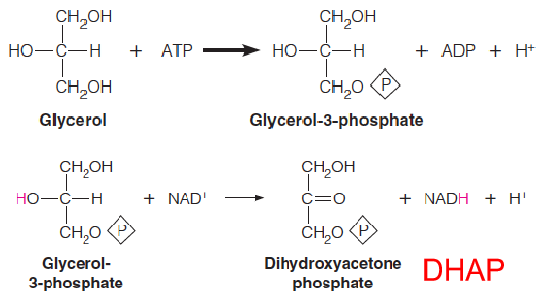
The digestion of neutral fat (triacylglycerols) and most phospholipids generates glycerol as one product.
In animals, glycerol first enters the glycolytic pathway by the action in liver of glycerol kinase.
The product is then oxidized by glycerol-3-phosphate dehydrogenase to yield dihydroxyacetone phosphate, which is catabolized by glycolysis.
合成脂肪的时候,需要DHAP去合成glycerol-3-phosphate,因此脂肪的合成代谢也需要糖
九、Polysaccharide Metabolism
In animal metabolism, two primary sources of glucose are derived from polysaccharides:
- Digestion of dietary polysaccharides, chiefly starch from plant foodstuffs and glycogen from meat.
- Mobilization of the animal’s own glycogen reserves.
Cleavage of a glycosidic bond by hydrolysis or Phosphorolysis
This formal diagram shows how the elements of water or phosphoric acid, respectively, are added across a glycosidic bond.
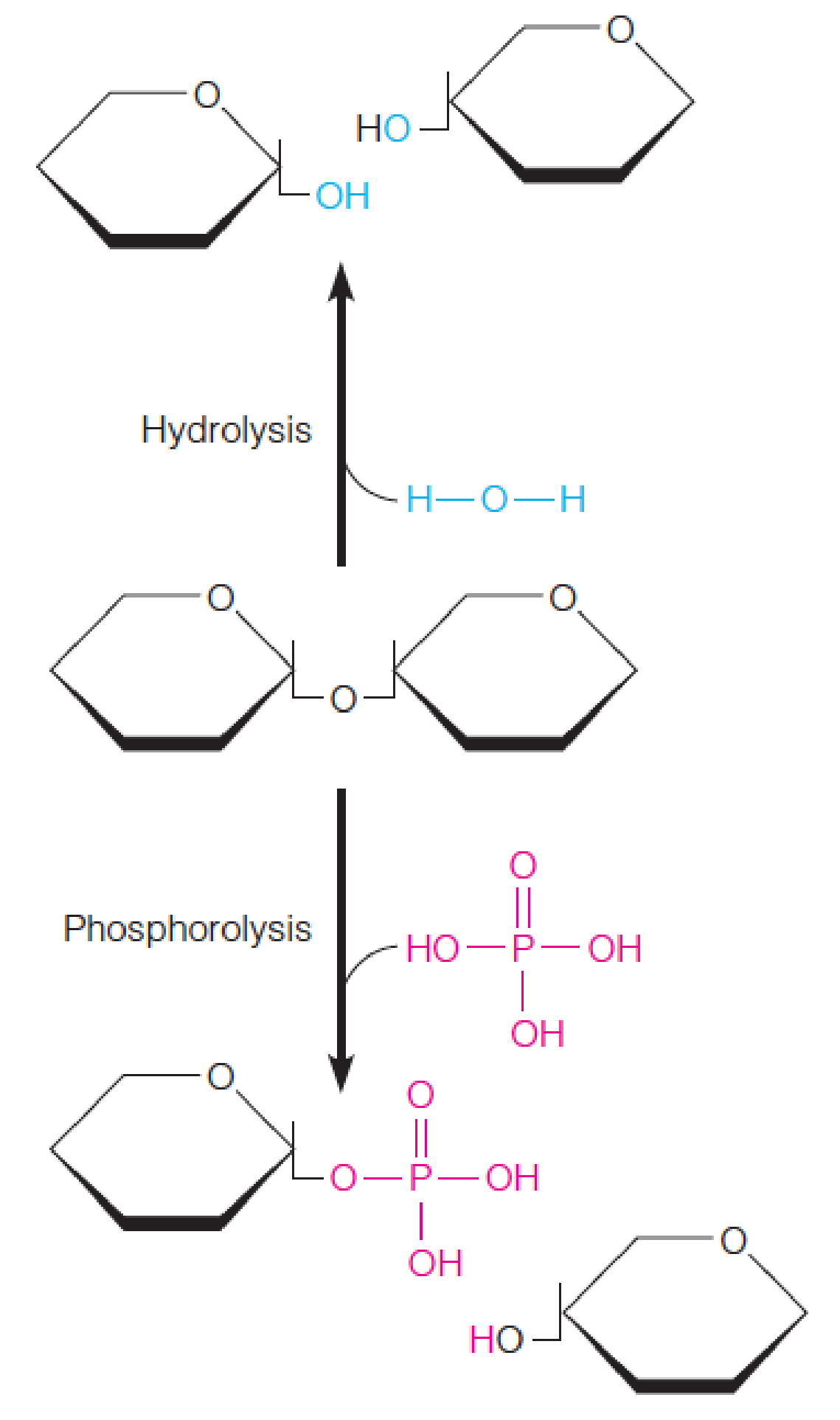
Dietary polysaccharides are metabolized by hydrolysis to monosaccharides.
Intracellular carbohydrate stores, as glycogen, are mobilized as phosphorylated monosaccharides by phosphorolysis.
$\alpha $-Amylase in saliva cleaves bonds a(1$\rarr$4) between the maltose units of amylopectin(支链淀粉) (or glycogen).
However, it cannot cleave $\alpha $(1$\rarr$6) glycosidic bonds in the branched polymer, and a limit dextrin(糊精) accumulates unless $\alpha $(1$\rarr $6)-glucosidase (debranching enzyme) is present.
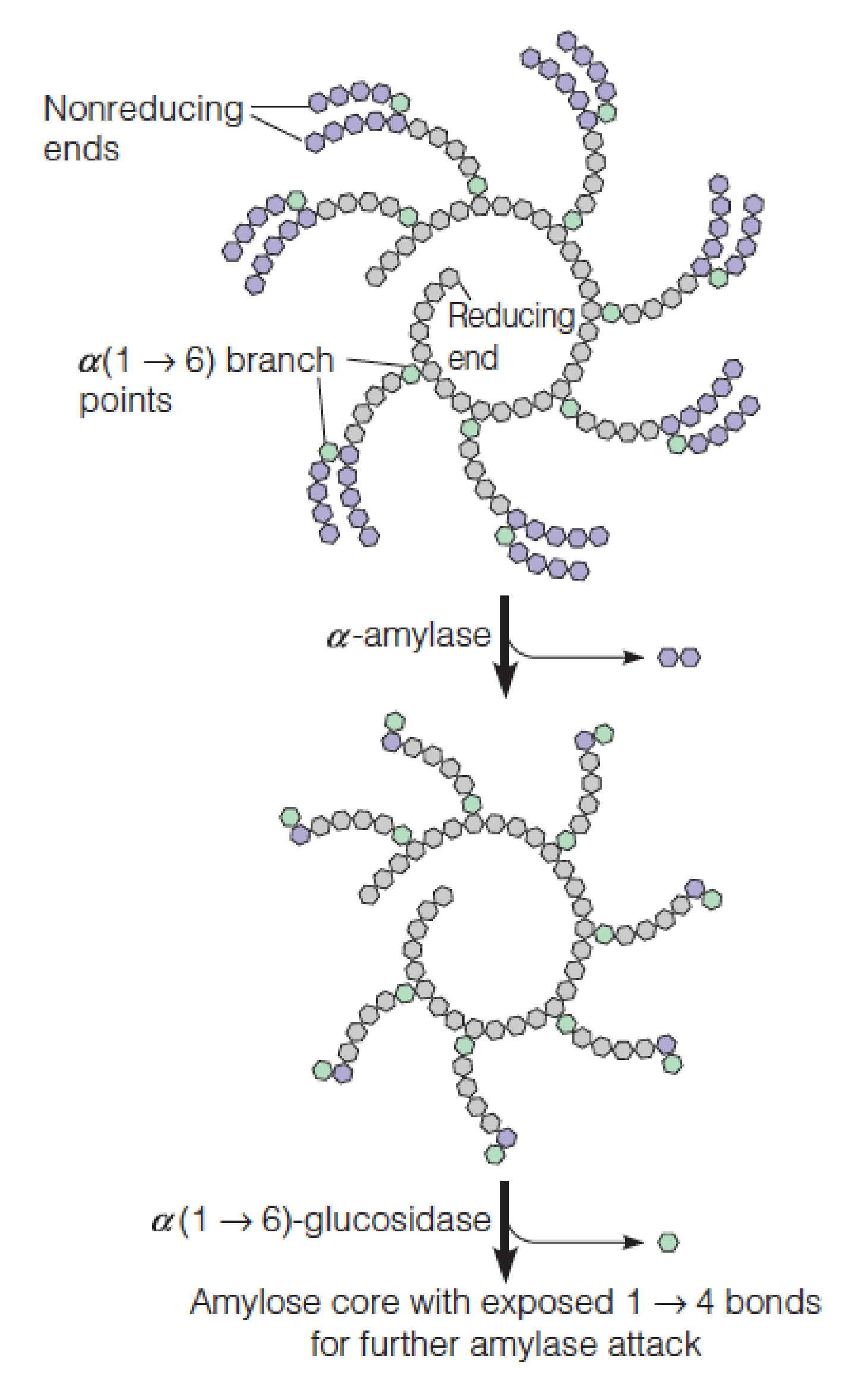
十、Glycogen Metabolism in Muscle and Liver
The principal glycogen stores in vertebrates are in skeletal muscle and liver.
Breakdown of these stores into usable energy, or mobilization of glycogen, involves sequential phosphorolytic cleavages of bonds, catalyzed by glycogen phosphorylase.
In plants, starch is similarly mobilized by the action of starch phosphorylase .
Both reactions release glucose-1-phosphate from nonreducing ends of the glucose polymer:

The debranching process in glycogen catabolism:
A glycogen chain following activity by phosphorylase (磷酸化酶), which cleaves off glucose residues to within four residues of the branch point.
The glycogen chain following transferase activity by the debranching enzyme. The three remaining glucose residues with linkage have been transferred to a nearby nonreducing end.
The glycogen chain following α(1$\rarr$6)-glucosidase activity by the debranching enzyme, which has removed the last remaining glucose residue of the branch.
- Phosphorylase will cleave off all but four glucose units of the newly elongated branch, beginning the debranching process again.
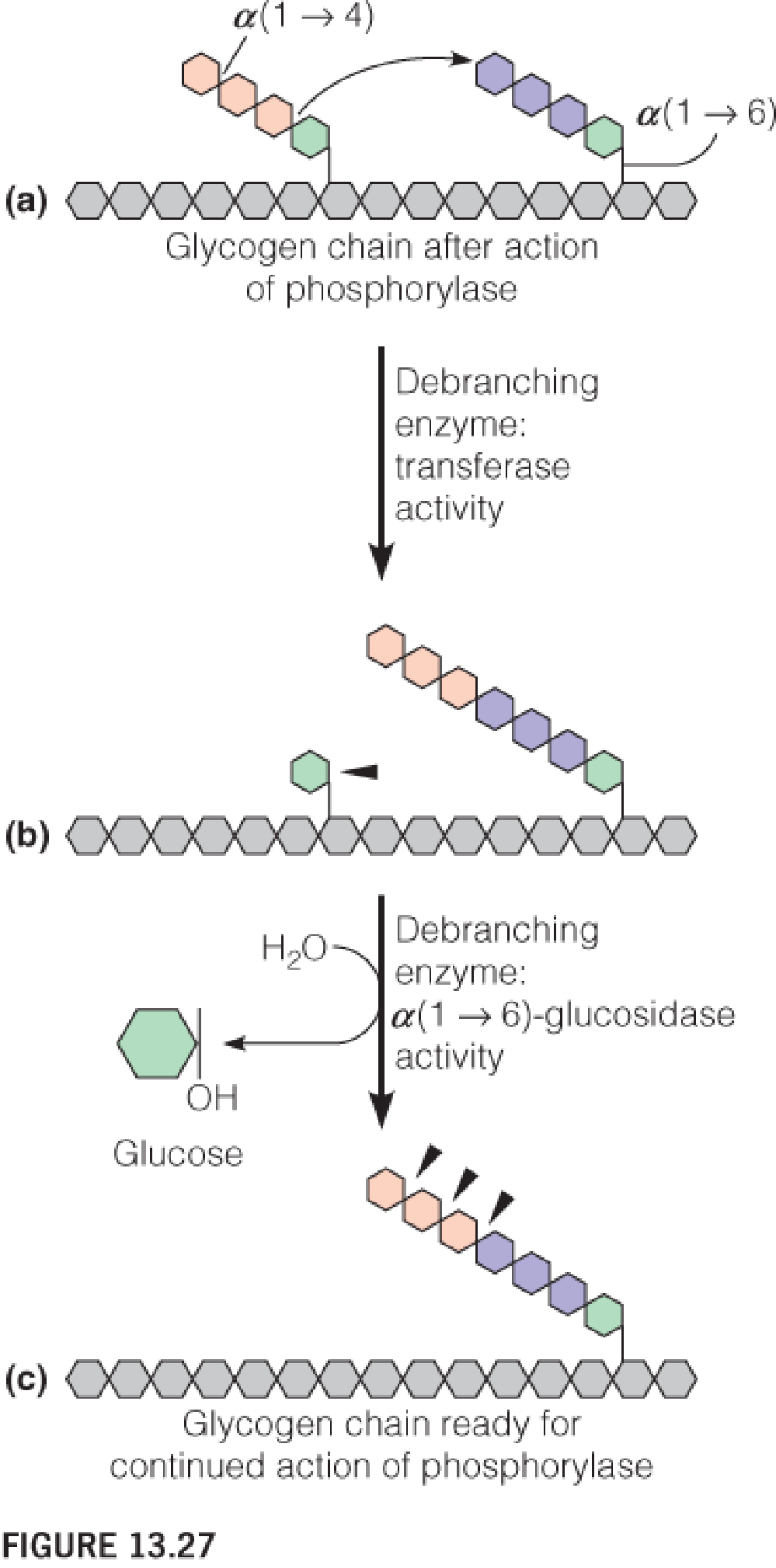
UDP-glucose is the metabolically activated form of glucose for glycogen synthesis.
所有的葡萄糖,只有变成UDP-Glc,才能用于合成糖原。这个转变的过程消耗能量,参与的分子是UDP。
Glycogen biosynthesis requires glycogen synthase for polymerization and a transglycosylase(转糖苷酶) to create branches.
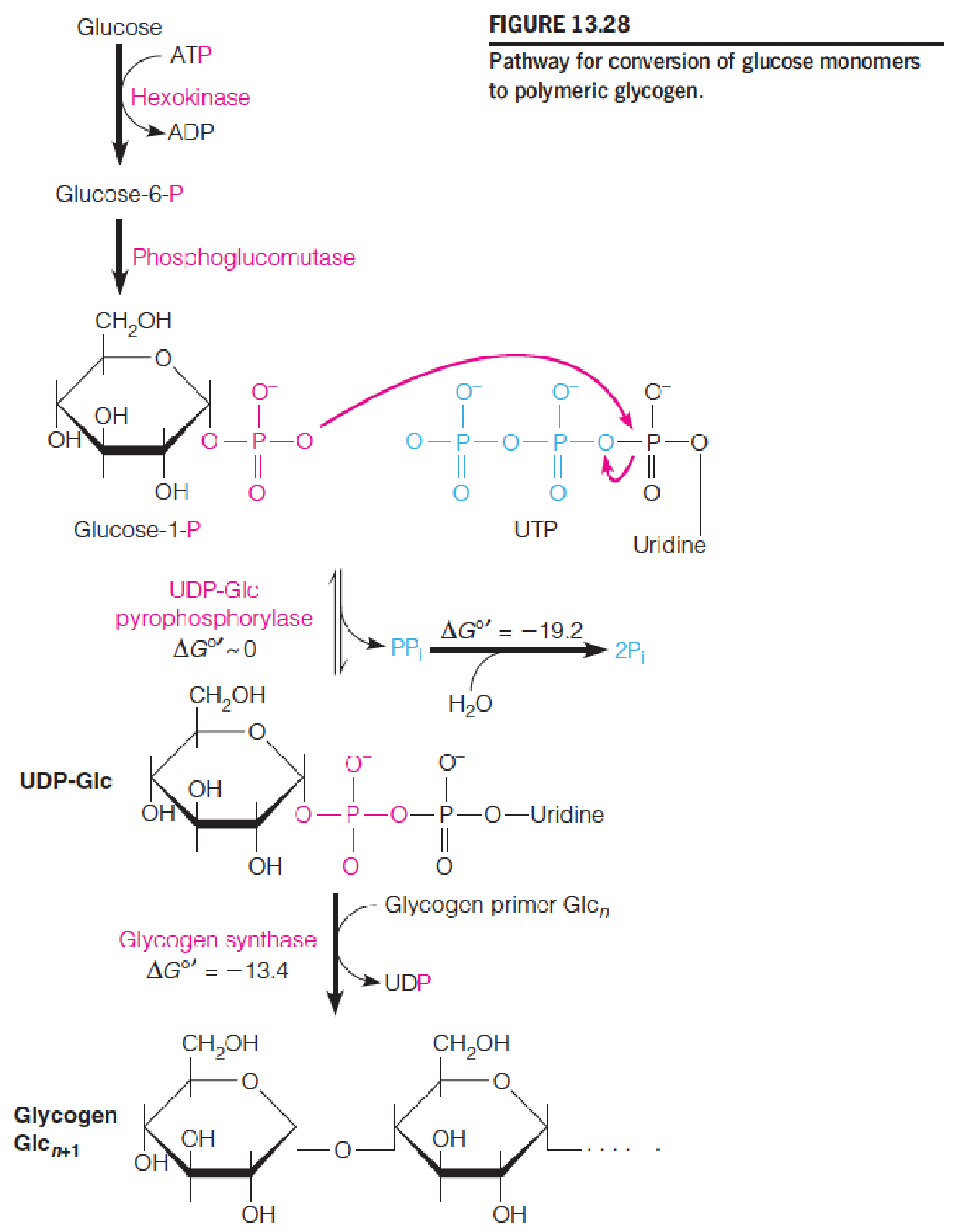
The glycogen synthase reaction:
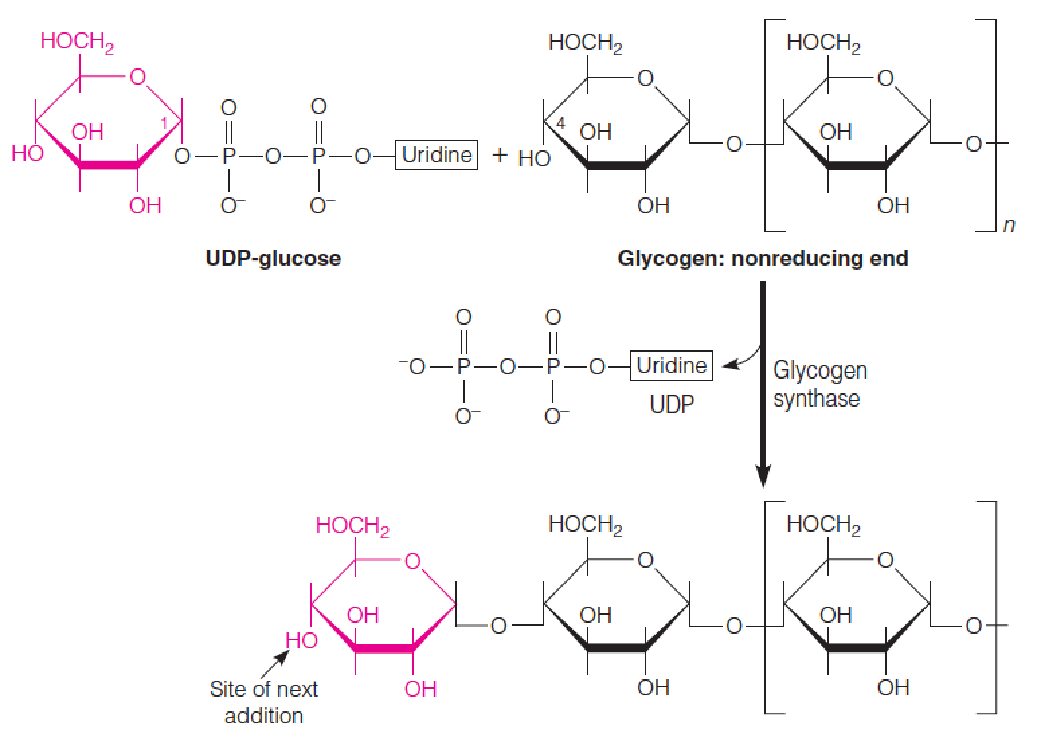
十一、Coordinated Regulation of Glycogen Metabolism
The branching process in glycogen synthesis.
Branching is brought about by the action of amylo-(1,4$\rarr$1,6)-transglycosylase.
由α1,4转变为α1,6,因此形成了分叉
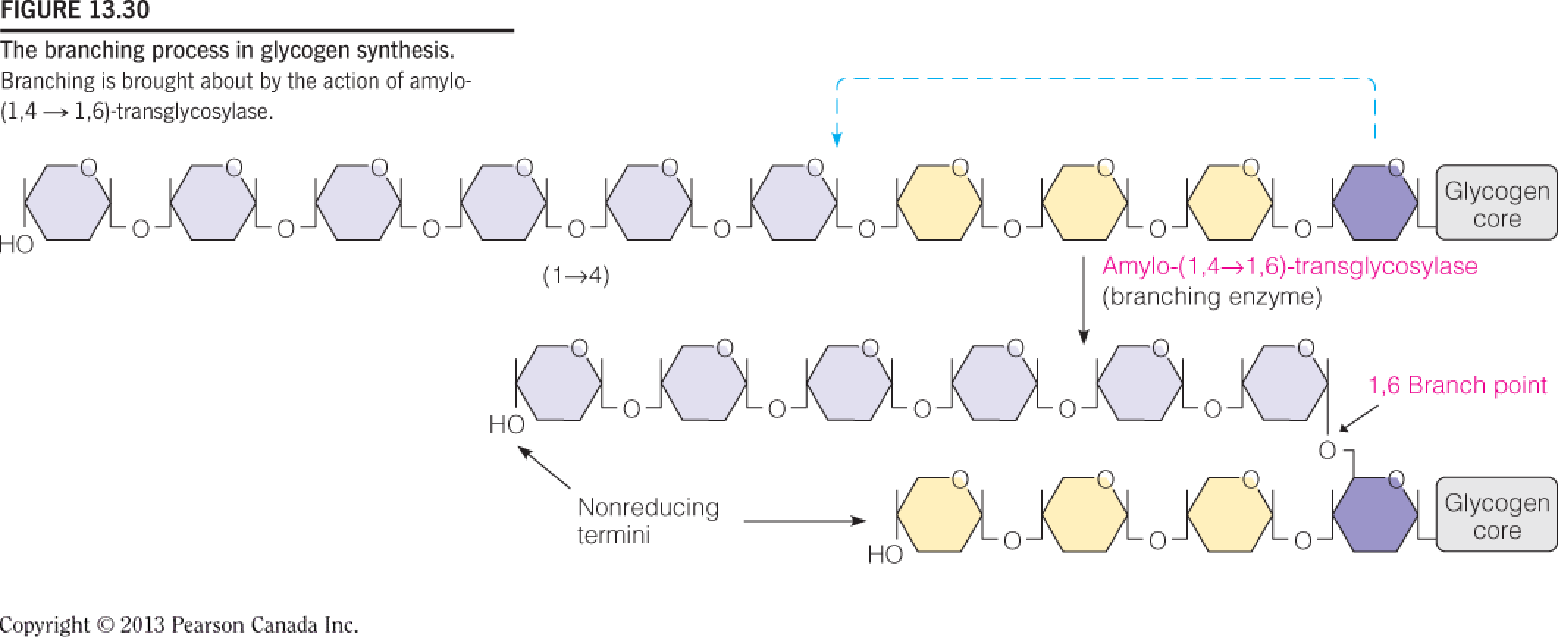
Glycogen mobilization is controlled hormonally by a metabolic cascade that is activated by cAMP formation and involves successive phosphorylations of enzyme proteins.
The rapid mobilization of muscle glycogen triggered by epinephrine is one of several components of the “fight or flight” response.
The regulatory cascade controlling glycogen breakdown
Epinephrine(肾上腺素), glucagon(胰高血糖素):
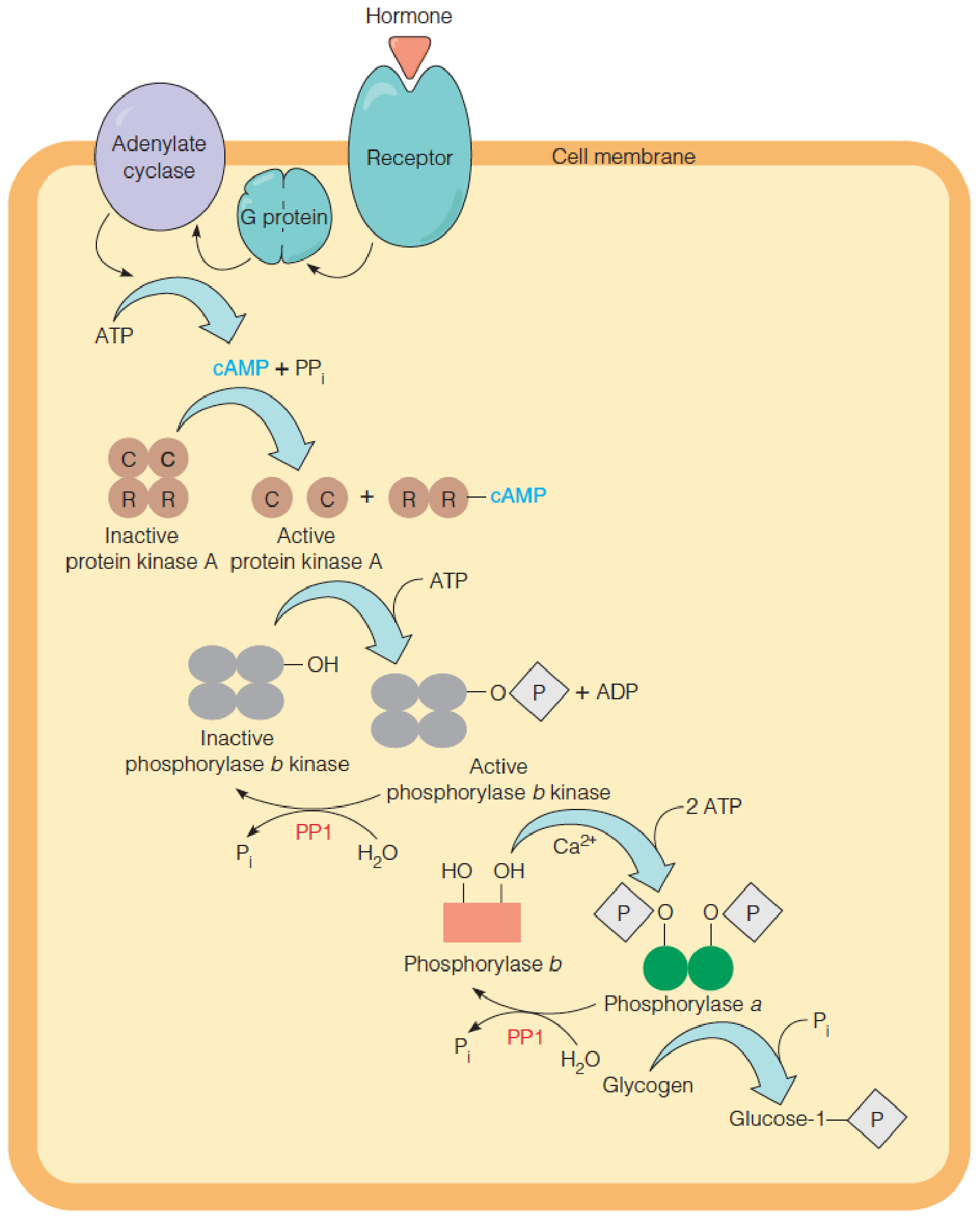
Control of glycogen phosphorylase activity
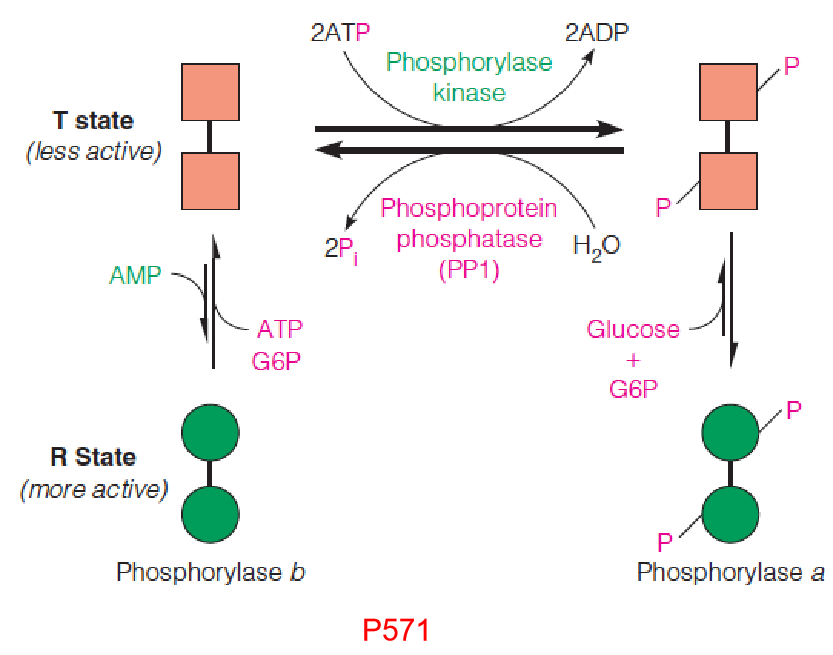
激酶使得T state磷酸化,从而激活活性
Conditions that activate glycogen breakdown inhibit glycogen synthesis, and vice versa.
Glycogen synthase activity is controlled by phosphorylation, through mechanisms comparable to those controlling glycogen breakdown by phosphorylase but having reciprocal effects on enzyme activity.
Control of glycogen synthase activity
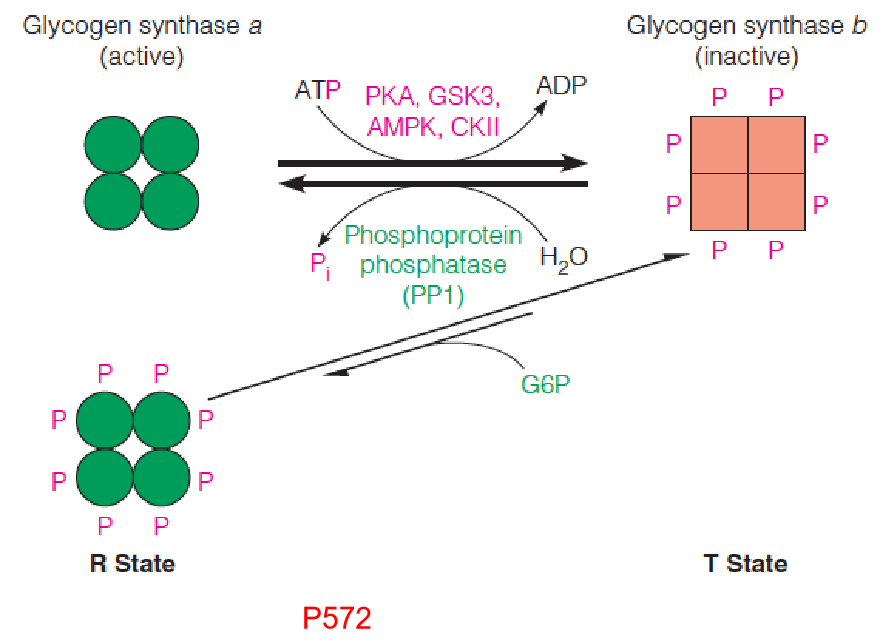
Glycogen synthase a 通过磷酸化,减少活性
Regulation of phosphoprotein phosphatase 1 (PP1)
1. in muscle
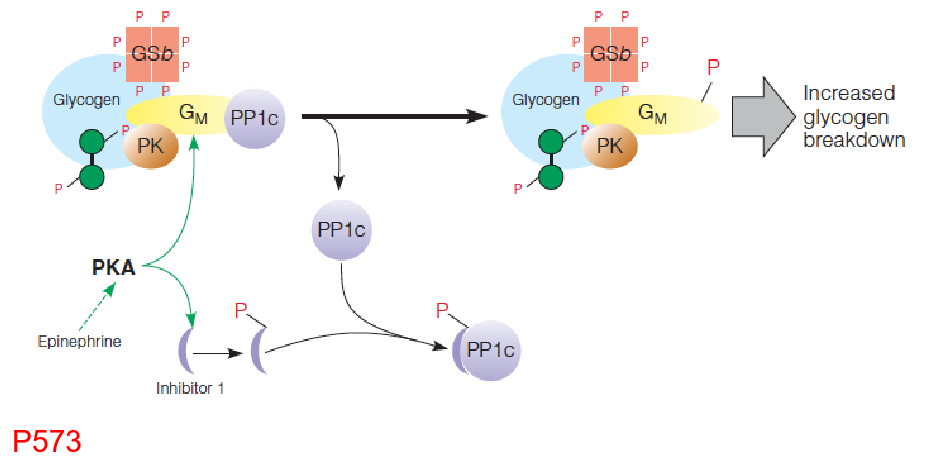
PKA磷酸化GM1,释放PP1c
Epinephrine → Gm phosphorylation ↑ → PP1c ↓ → glycogen synthesis ↓ glycogen breakdown ↑
2. in liver
肝细胞内部PP1的调节与G6P,Glucose有关
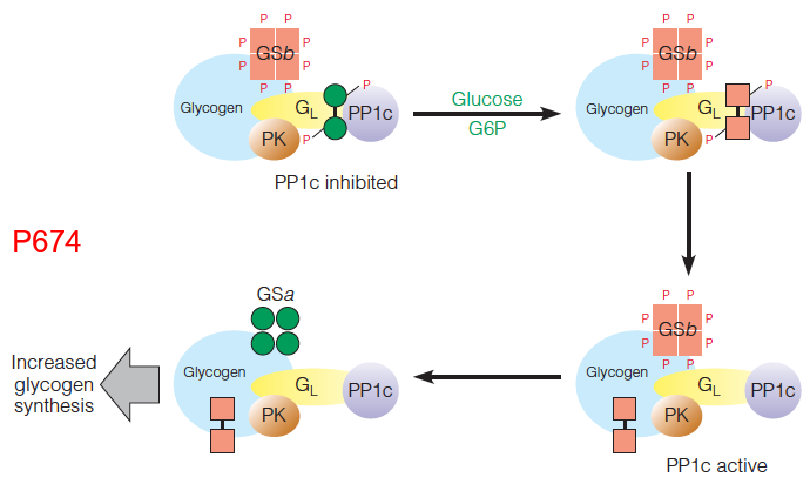
G6P favors T state of glycogen phosphorylase a, which is dephosphorylated by PP1c → glycogen phosphorylase a → glycogen breakdown ↓ glycogen synthesis ↑
3. Glycogen storage diseases
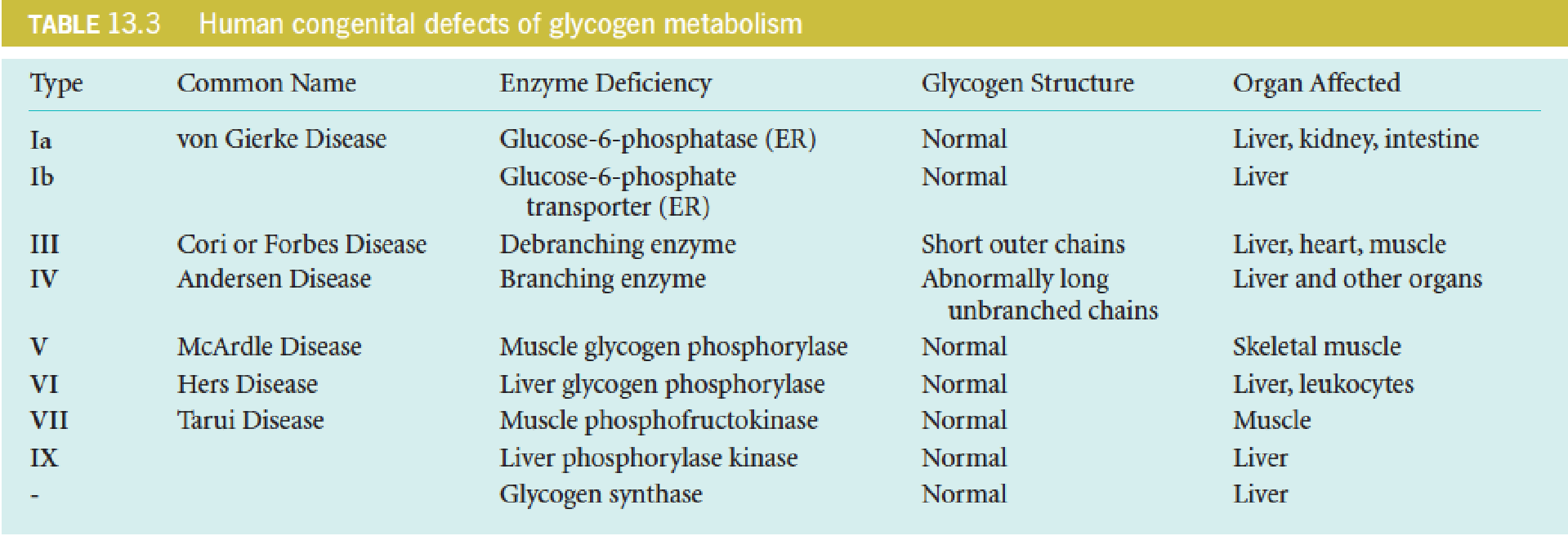
十二、A Biosynthetic Pathway That Oxidizes Glucose: The Pentose Phosphate Pathway (PPP)
The pentose phosphate pathway(戊糖磷酸途径) converts glucose to various other sugars, which can be used for energy.
Its most important products, however, are NADPH and ribose-5-phosphate (R5P,5-磷酸核酮糖). R5P是合成DNA,RNA的部件分子。
In stage 1, the oxidative phase, glucose-6-phosphate is oxidized to ribulose-5-phosphate and CO2, with production of NADPH.
The remaining stages constitute the nonoxidative phase of the pathway.
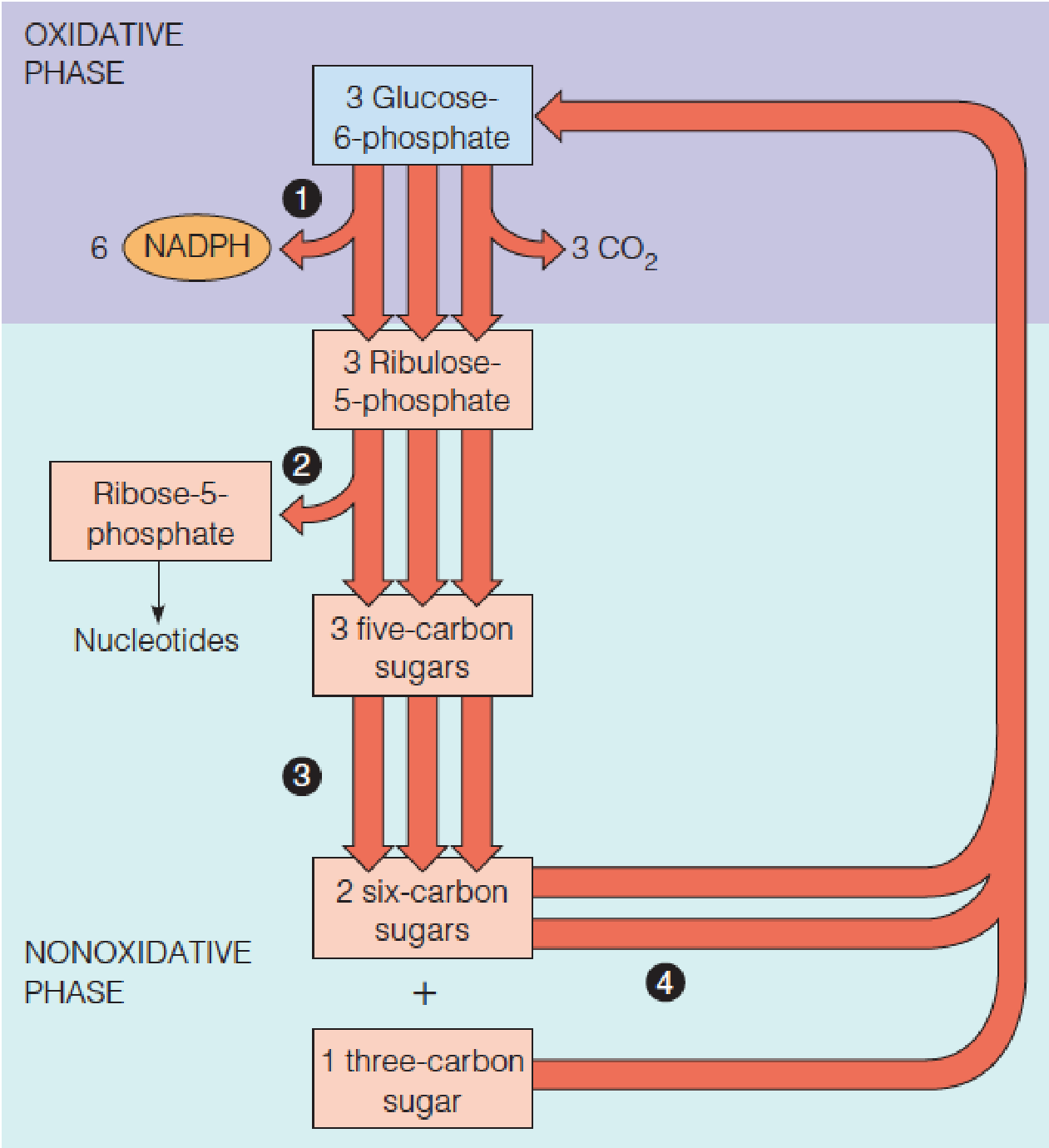
Oxidative phase of the pentose phosphate pathway
The three reactions of the oxidative phase include two oxidations(脱氢), which produce NADPH.
The pentose phosphate pathway primarily generates NADPH for reductive biosynthesis and ribose-5-phosphate for nucleotide biosynthesis.
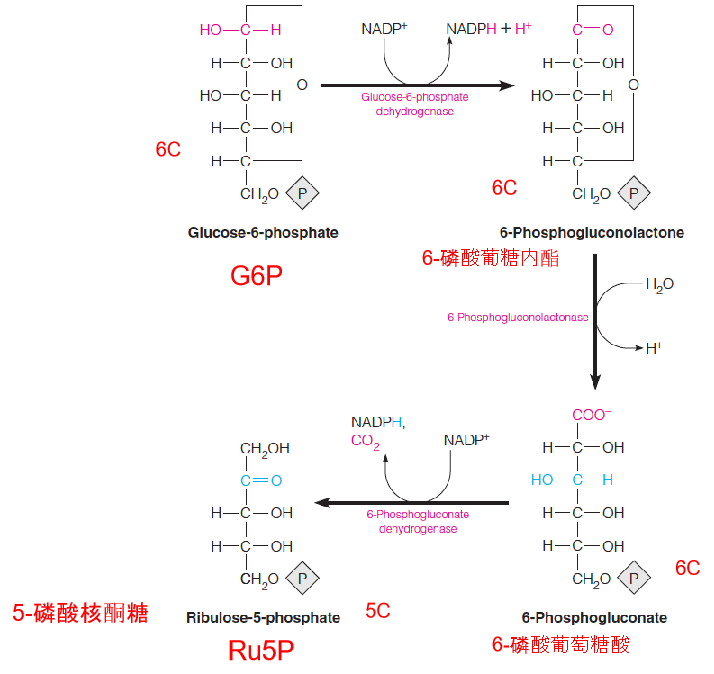 Oxidative Nonoxidative phase of the pentose phosphate pathway
Oxidative Nonoxidative phase of the pentose phosphate pathway
In the nonoxidative phase, some of the ribulose-5-phosphate produced in the oxidative phase is converted to ribose-5 phosphate by phosphopentose isomerase.
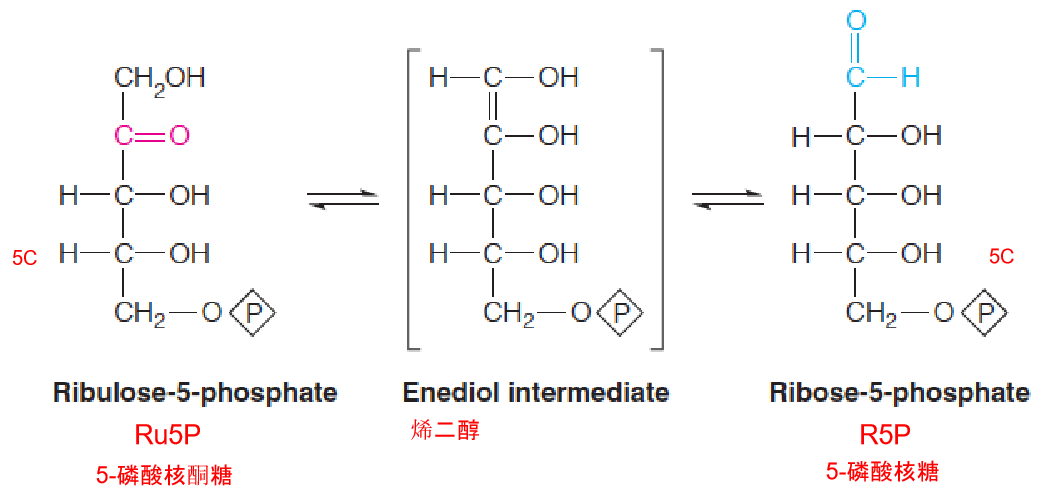
The reaction sequence of the nonoxidative branch converts 3 five-carbon sugar phosphates to 2 six-carbon sugar phosphates and 1 three-carbon sugar phosphate.
The hexose phosphates(己糖磷酸) formed can be catabolized either by recycling through the pentose phosphate pathway or by glycolysis.
The triose phosphate(丙糖磷酸) is glyceraldehyde-3-phosphate, a glycolytic intermediate.
Three enzymes involved are:
phosphopentose epimerase 磷酸戊糖差向异构酶
transketolase 转酮醇酶
transaldolase 转醛缩酶
The nonoxidative branch begins with both ribulose-5-phosphate and ribose-5-phosphate.
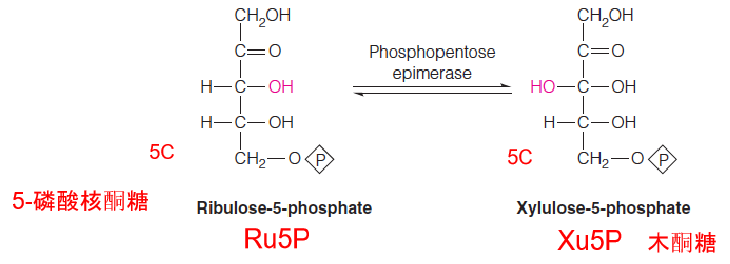
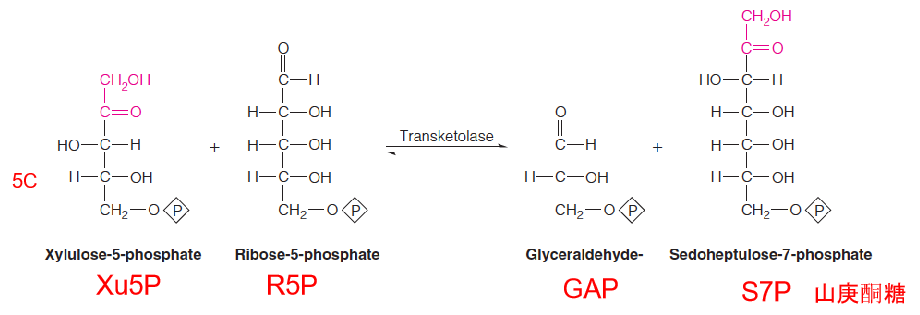
Transketolase catalyzes a transfer of a two-carbon fragment from xylulose-5-phosphate to ribose-5-phosphate to give a triose phosphate, glyceraldehyde-3-phosphate, and a seven-carbon sugar, sedoheptulose-7-phosphate.
In the final reaction of pentose phosphate catabolism, transketolase acts on another molecule of xylulose-5-phosphate, transferring a glycolaldehyde fragment to erythrose-4-phosphate and generating a three-carbon product and a six-carbon product—glyceraldehyde-3-phosphate and fructose-6-phosphate, respectively.

Transketolase requires a TPP cofactor to transfer its 2-carbon unit as an activated aldehyde.
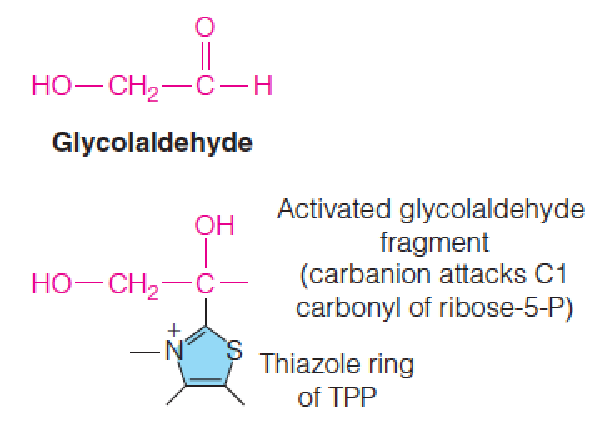
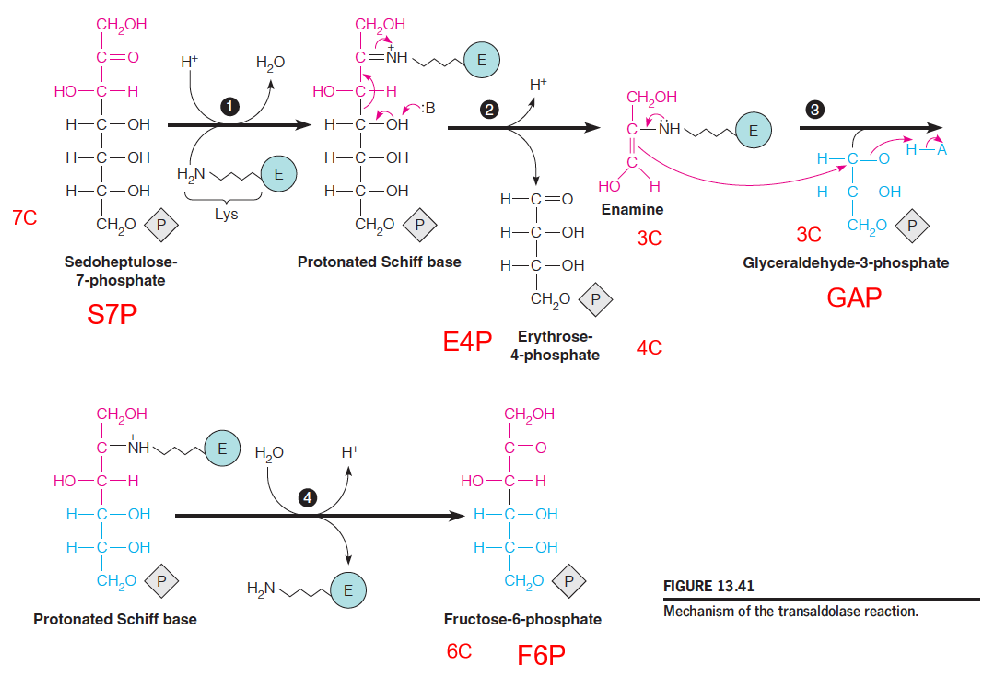
Comparison of C-C bond cleavage in transketolase and transaldolase reactions:
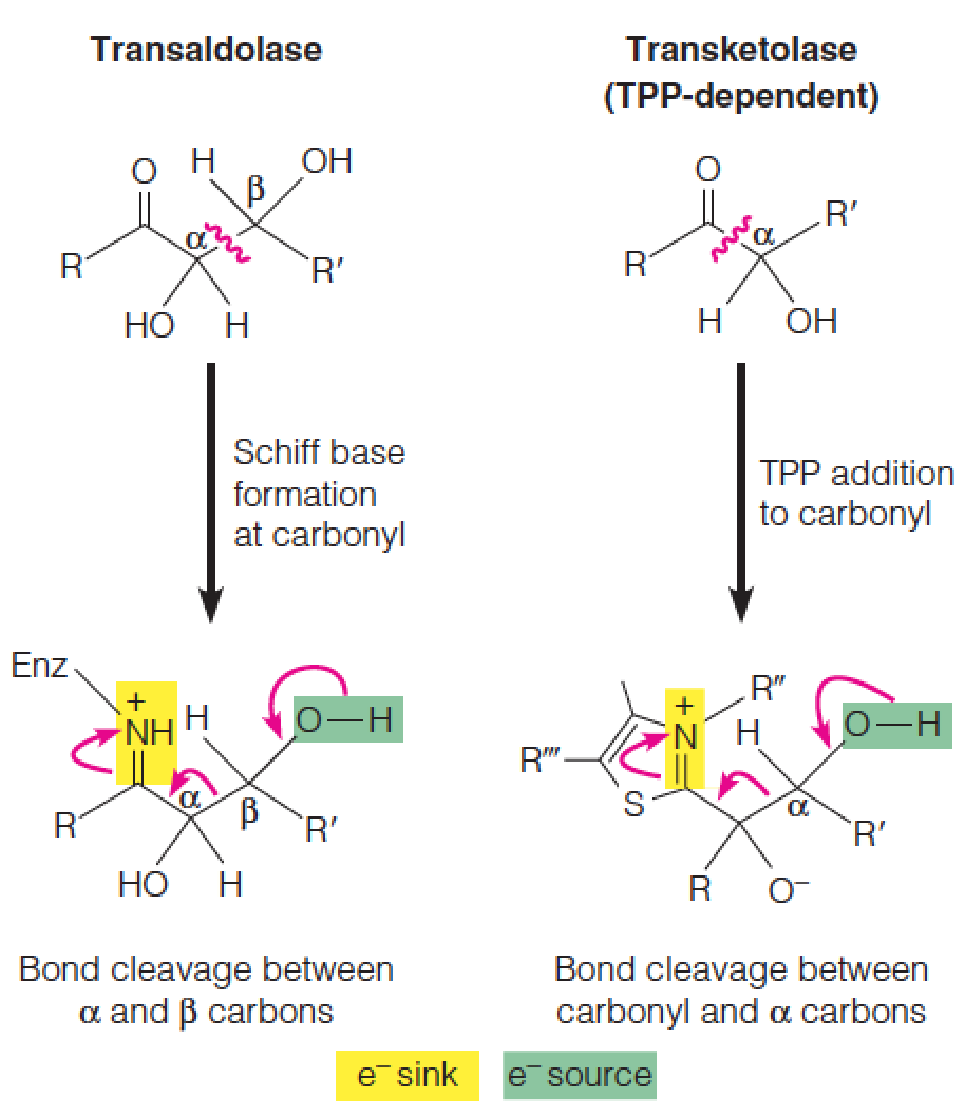
The pentose phosphate pathway has different modes of operation to meet varying metabolic needs.
- When the primary need is for nucleotide biosynthesis, the primary product is ribose-5-phosphate. Reducing equivalents from NADPH are used to reduce ribonucleotides to deoxyribonucleotide.
- When the primary need is for reducing power (NADPH), fructose phosphates are reconverted to glucose-6-phosphate for reoxidation in the oxidative phase.
- When only moderate quantities of pentose phosphates and NADPH are needed, the pathway can also be used to supply energy, with the reaction products being oxidized through glycolysis and the citric acid cycle.
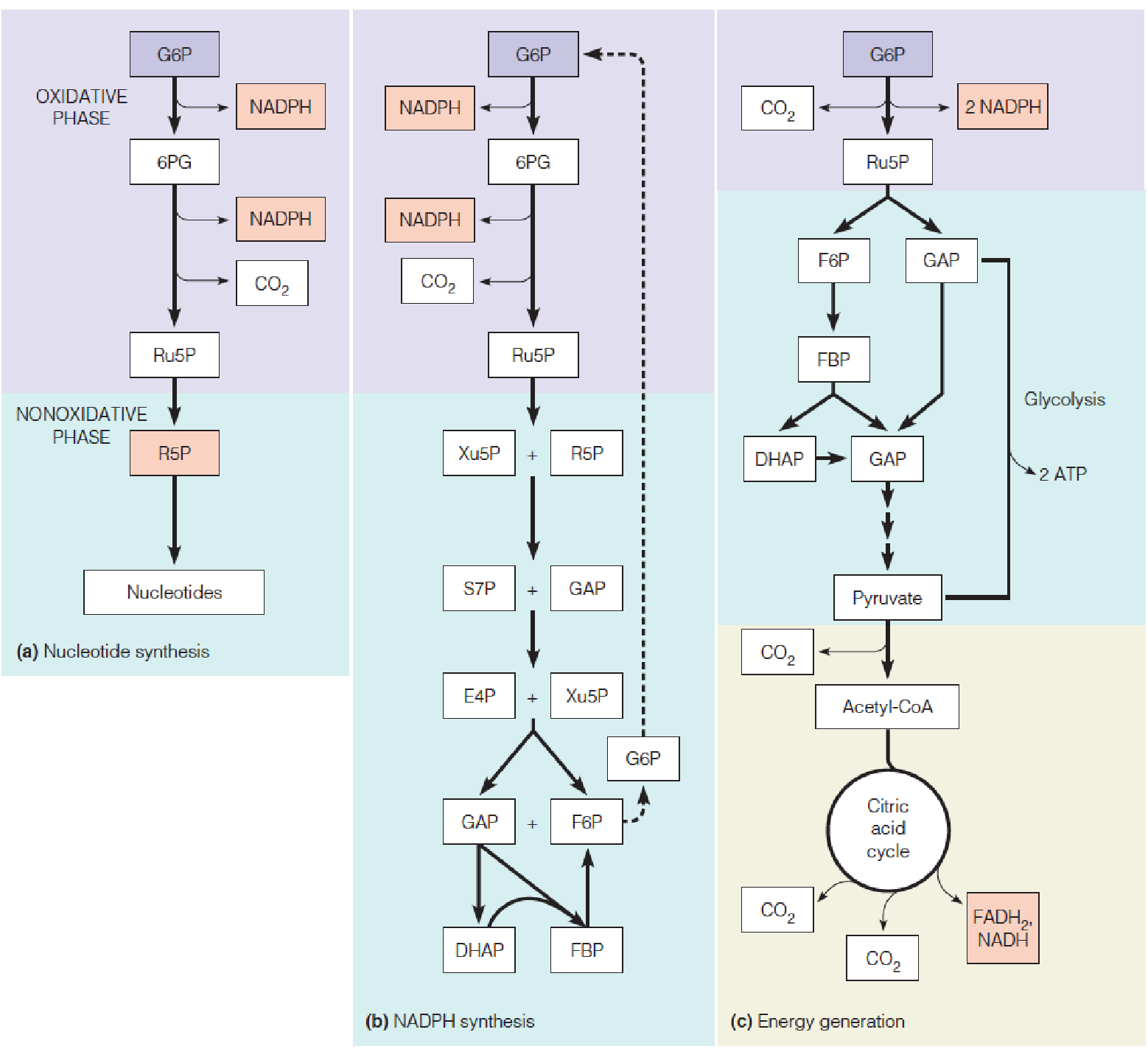 $$
30-3=27; \ 32-5 = 27\\
\frac{27-4 }{2} \text{ ATPs}=11.5 \text{ ATPs}
$$
$$
30-3=27; \ 32-5 = 27\\
\frac{27-4 }{2} \text{ ATPs}=11.5 \text{ ATPs}
$$